Balboa Park in San Diego is a 1,200-acre cultural park with attractions such as museums, theaters, gardens, shops, and restaurants. The park features Spanish Colonial Revival architecture, including the latticed Botanical Building and the Bea Evenson Fountain. With its beautiful scenery, free parking, and diverse exhibits, it's a must-visit destination worth spending a day strolling around, even if you don't visit any specific attractions.
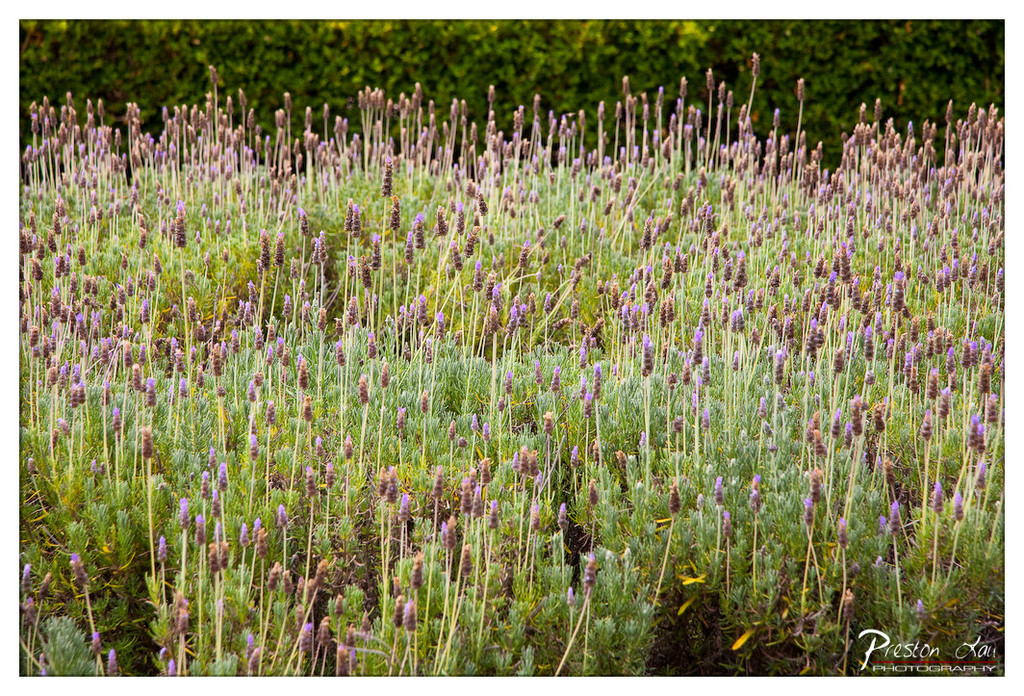

Lavender Labyrinth
Rating: 8/10
Ah, the classic field of lavender! A sea of fuzzy purple spires stretching towards what looks like a rather stern green hedge acting as a backdrop. What's happening here is a full-scale takeover by nature's scented soldiers, standing tall and proud (or maybe just slightly slumped after a long day). The mood is undeniably tranquil and fragrant, though looking at the sheer density of it all, one might feel a tad overwhelmed, like being lost in a very polite, purple mosh pit. The subject matter itself is lovely, a photogenic plant if ever there was one, but capturing the *essence* of a dense field is tricky. There are countless individual lavender flower spikes, their thin stems forming a vertical tapestry, interspersed with the grey-green foliage of the plants below. The background, a soft blur of dark green, thankfully doesn't distract but could perhaps offer a little more separation or a hint of context beyond "more green stuff."
From a photography perspective, the composition leans heavily on filling the frame with texture, creating a visual wall of lavender. While effective in conveying abundance, it lacks a clear focal point – where does the eye go? It just sort of washes over the whole scene. Lighting appears fairly even, maybe slightly diffused, which is great for capturing detail and color across the field without harsh shadows, but it doesn't offer much dramatic punch or highlight the individual structures particularly well. A touch of golden hour side-lighting could have made those textures pop! The colors are pleasant; the muted purples and greens feel natural, though perhaps a slight nudge in saturation might lift the image without making it look artificial. It's a solid nature shot, well-exposed and capturing the subject matter accurately, but it plays it a bit safe. It needs a story, a leading line, or maybe just one slightly rebellious bee to really make it sing.
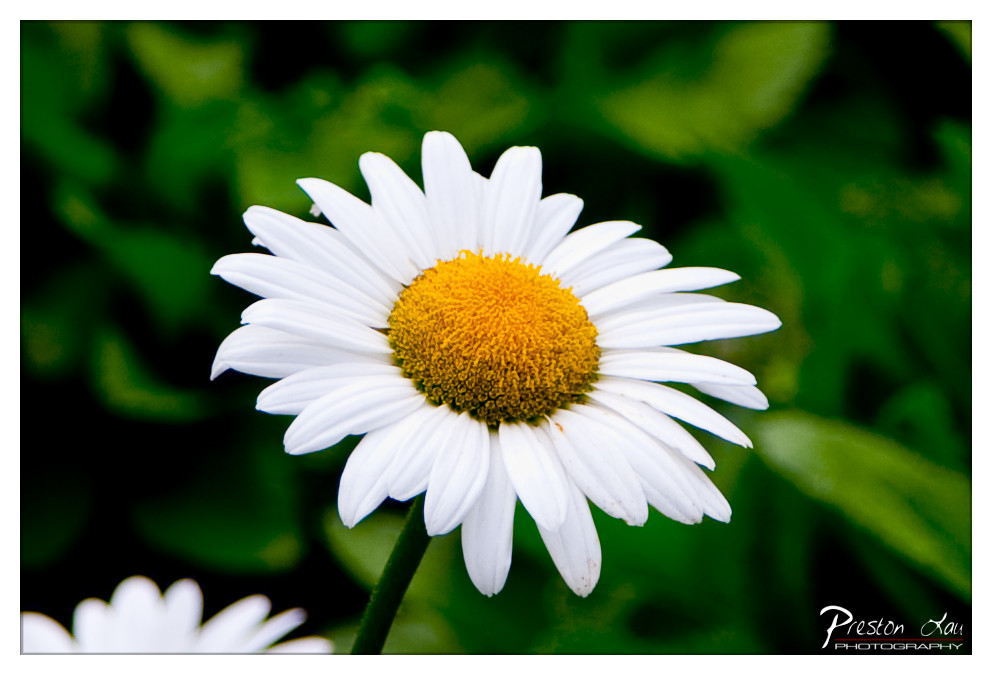

Title: The Confident Daisy Strikes a Pose
Rating: 7/10
Behold, the simple yet undeniably charismatic common daisy, giving us its best angle like it's posing for a botanical glamour shot. This particular specimen is clearly the star of the show, dominating the frame with its crisp white petals radiating outwards like a tiny, natural sunbeam catcher. What's happening? Well, it's just being a daisy, looking effortlessly cheerful against a sea of moody, out-of-focus green foliage. There's even a cameo appearance from another blurry daisy down in the corner, clearly not quite ready for its close-up, adding a touch of depth to the foreground. The overall mood is one of serene, uncomplicated nature, maybe a little *too* serene if you're looking for high drama, but perfect for a moment of floral appreciation.
From a photographic perspective, this shot uses the classic technique of shallow depth of field to isolate the main subject from the background. The deep green bokeh is quite pleasing, providing a dark, contrasting canvas that makes the bright white and vibrant yellow of the daisy pop right off the screen. The composition places the flower slightly off-center, following the rule of thirds loosely, which adds a bit more visual interest than a straight-on shot, though the leaning stem feels a little cut off. Lighting appears soft and even, nicely highlighting the textured center without harsh shadows. While a daisy is a pretty standard subject, the sharp focus and clean execution make it a solid example of getting the basics right – proving sometimes, simple beauty is all you need (plus a decent lens and some photographic know-how). And, of course, the classic "Preston Lau Photography" watermark reminds us who captured this moment of floral fortitude.
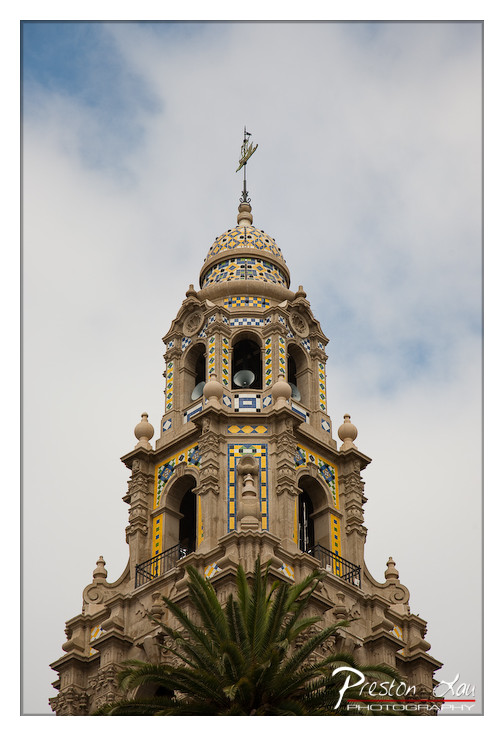

Where the Speakers Live
Rating: 8/10
The subject of this shot is a wonderfully ornate tower, dripping with architectural details and crowned with a quirky ship-shaped weather vane. What's happening? This grand structure is simply existing, showcasing its intricate design and likely waiting for its bells (or maybe just the modern speakers visible in its arches?) to announce the time or maybe the start of a guided tour. The mood is one of quiet grandeur, slightly tempered by the flat, overcast lighting, making the building feel solid and enduring, but perhaps a little sleepy under the grey sky. The composition is a vertical emphasis on the tower's upper levels, framing it against the sky and allowing its decorative features, particularly the colorful tiles, to take center stage. It's a straightforward portrait of the architecture, aiming to capture its form and detail without much in the way of dynamic perspective.
Looking closer, the lighting, while lacking drama, does an admirable job of revealing the textures of the stone and the vibrant blues and yellows of the decorative tiles, which are undeniably the star pattern of the show. These pertinent objects, including the arches, the delicate balcony railing, the slightly incongruous modern speakers, and the nautical weather vane, each add their own touch of character to the structure. A splash of green from a foreground palm tree adds a touch of the environment, though it does obscure the tower's lower section. The background is an uninspiring expanse of overcast sky, which serves its purpose of isolating the subject but offers little visual excitement. It's a solid shot capturing the essence of the building, though a photographer might lament the lack of directional light or a more dynamic sky to truly make the colors pop and the details sing. And yes, the watermark ensures attribution, because towers this fancy demand their photographer be known!
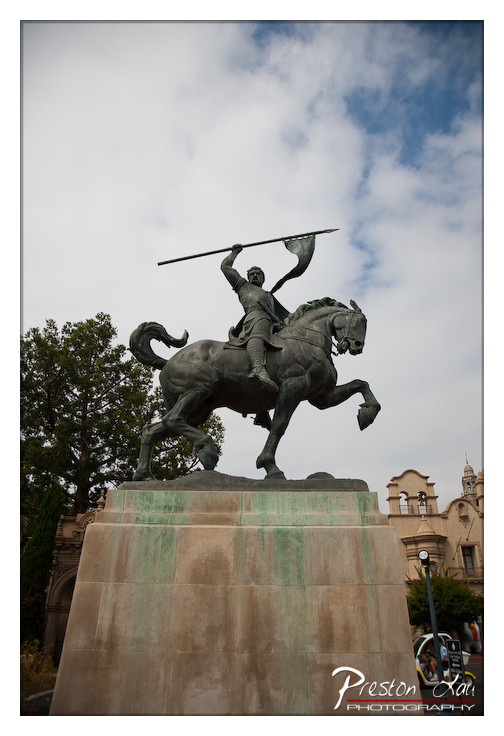

Rearing into the Grey
Rating: Subject: 9/10
This image presents a magnificent bronze equestrian statue, featuring a warrior-like figure holding aloft a spear with a pennant, mounted on a powerful, rearing horse. The sheer scale and dramatic pose of the sculpture are impressive, easily earning the subject a 9/10 rating; it’s certainly not blending into the background. The figure and horse are captured from a low angle, a classic compositional technique to emphasize their height and power, making the horse look like it's about to gallop right out of the frame and perhaps onto the nearest golf course, given the vehicle glimpse. The statue stands on a multi-tiered stone base, itself a substantial structure, set against a background of mature trees and distinctive architecture that suggests a location with historical significance, giving the scene a grand, if slightly muted, tone under the cloudy sky.
Photographically, the choice of a low perspective successfully conveys the monument's imposing presence, though it does introduce a slight upward tilt distortion. The lighting is soft and diffused, courtesy of the overcast conditions, which renders the details of the bronze and stone clearly but results in a relatively flat image lacking strong contrast or vibrant color, leaning towards a palette of greys, greens, and muted earth tones. The background, featuring classic arches and bell towers contrasting with the dark mass of trees, adds depth and context. The composition places the statue centrally, but the watermark "Preston Lau PHOTOGRAPHY" in the lower right, almost cheekily adjacent to a blurry modern electric cart with passengers, provides a touch of humor and anchors the image firmly in the contemporary moment, reminding us that even timeless heroes share the street with tourist transport.
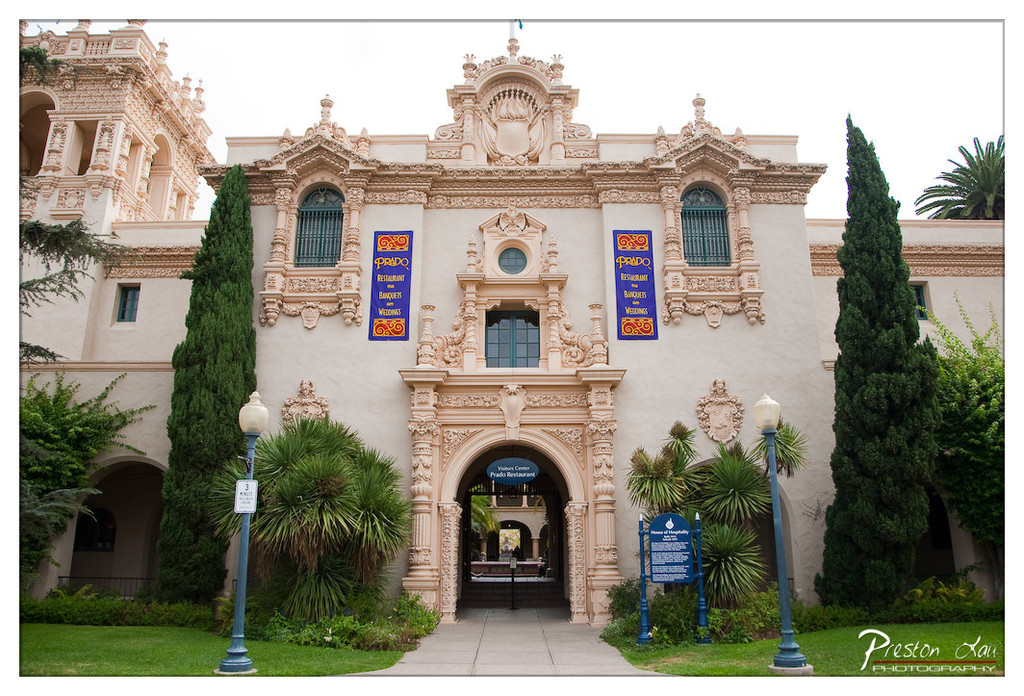

A Grand Entrance Fit for Paella
Rating: 7.5/10
This photograph presents the ornate facade of a beautiful Spanish Colonial Revival building, likely a historical landmark or significant cultural center, currently housing "The Prado Restaurant, Banquets, and Weddings," as cheerfully announced by two prominent blue banners. The architecture is the undisputed star, boasting intricate carvings, arched doorways, and decorative window grilles that speak of craftsmanship and history. The scene is set on a bright day, though perhaps overcast, providing soft light that gently illuminates the detailed stonework and stucco. Lush greenery, including tall cypress trees flanking the entrance like stoic guards and various palm-like shrubs, adds life and contrast to the beige structure. A paved walkway leads directly to the central arched entrance, inviting visitors into the cool shade within. Informative signs and a classic street lamp complete the foreground, suggesting a well-maintained public space ready to welcome guests for dining or special events. The overall mood is stately and inviting, hinting at elegance and perhaps good food.
From a photographer's perspective, the composition leans heavily on symmetry, centering the main entrance, which is a solid choice for architectural shots, though the slight offset of the tower on the left adds a touch of dynamic imbalance. The soft lighting is excellent for showing off the building's textures and details without harsh shadows, but the sky has completely blown out, losing all cloud definition and creating a stark white backdrop that distracts slightly. The towering cypress trees are visually striking, but the one on the left, paired with the awkward placement of the street lamp and foreground sign, creates a somewhat cluttered feel on that side. The banners, while informative about the subject's current use, feel a bit jarring against the timeless architecture – "Yes, yes, we see the historical beauty, but is it also available for Bob and Carol's rehearsal dinner?" Despite these quibbles, it's a competent capture that successfully highlights the building's grand presence and intricate beauty, serving as a useful visual record of the structure and its current purpose.
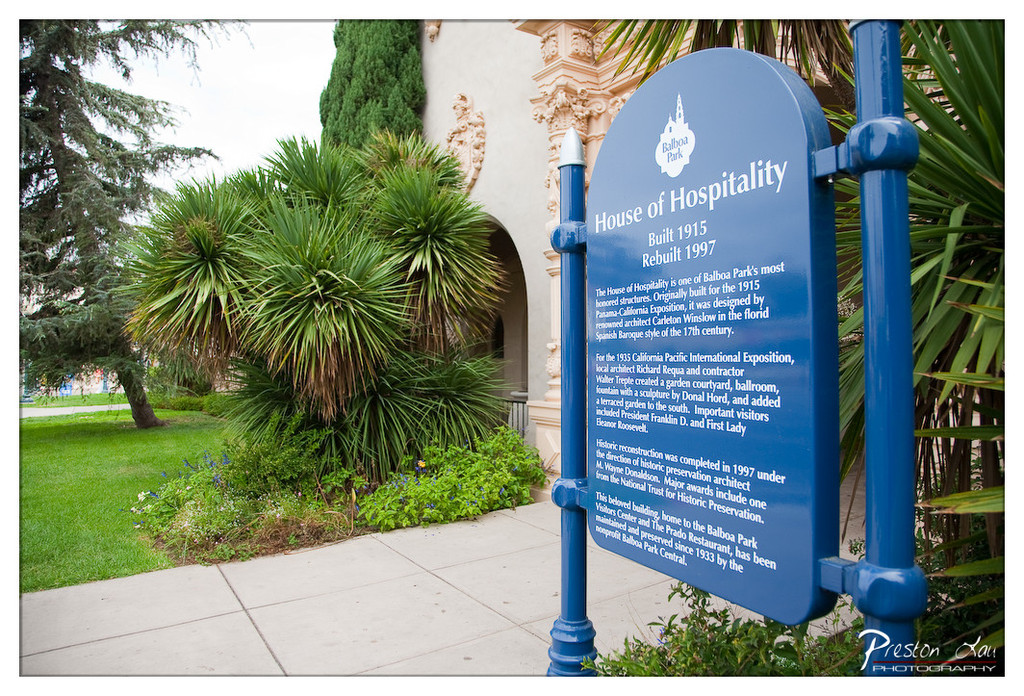

House of Sign-pitality
Rating: 7/10
Well, hello there, Big Blue Sign! It seems you've stolen the show from the actual House of Hospitality, which is hiding coyly in the background. This photo captures the essence of "Read All About It!" with a rather imposing blue sign serving as the undeniable star. Flanked by spiky, palm-like plants that look like they're perpetually having a bad hair day, the sign proudly declares its identity and history. The mood is informative and serene, typical of a pleasant day strolling through a park, albeit one where signs demand your full attention. In the foreground, a clean sidewalk guides the eye, while a patch of vibrant green lawn and some delicate blue flowers add a touch of natural beauty that slightly softens the rigid structure of the sign.
From a photographic perspective, the composition is straightforward and functional – the sign is dead center (or close enough) and perfectly readable, which, let's face it, is the whole point of photographing a sign. The lighting is beautifully even and diffused, likely thanks to some nice cloud cover, preventing any harsh glare off that brilliant blue surface – a win for visibility, if not for dramatic shadows. The colors are simple but effective: the strong blue contrasts nicely with the natural greens and the creamy building facade behind. While the subject itself – a sign – isn't the most thrilling visually, the photographer has successfully captured it in context, making sure you know *exactly* where you are and what you're looking at, even if the actual architectural subject takes a backseat. It's documentary photography at its finest, proving that sometimes, the most important story is literally written out for you.
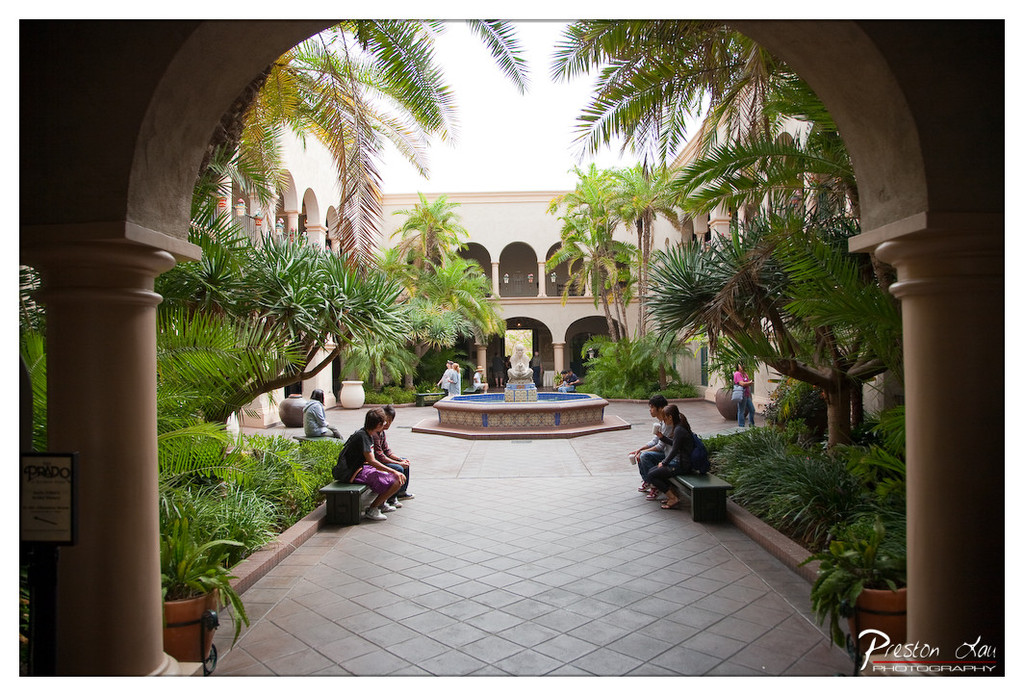

Title: Courtyard Conversations Under the Arches
Rating: 7/10
This inviting image drops us right into a serene courtyard, framed rather dramatically by thick archways on the left and right, giving us that classic keyhole view effect – because who needs an unobstructed view when you can have a giant column in the foreground, right? The central subject is undoubtedly the peaceful courtyard itself, anchored by a rather elegant multi-tiered fountain adorned with intricate tiles and a bust on top, trying its best to look important amidst all the lush greenery. People are dotted around, adding a touch of life and scale; a couple groups are lounging on benches in the foreground and middle ground, presumably discussing the optimal angle for a palm tree photo, while others mill about near the fountain. The mood is overwhelmingly tranquil and relaxed, practically screaming "find a bench and forget your worries," or perhaps "find a bench because you've walked too much today."
From a photographic perspective, the composition leans heavily on the foreground framing, which works to draw your eye inward towards the fountain, but also eats up a significant portion of the frame. The leading lines from the diamond-patterned paving are a nice touch, guiding your gaze towards the heart of the courtyard. Lighting appears soft and diffused, likely an overcast day or shaded, which is great for avoiding harsh shadows and keeping colors muted but pleasant – the greens of the palms and other foliage pop nicely against the warm tones of the architecture and ground tiles. It’s a well-executed shot capturing the atmosphere of a lovely public space, perhaps slightly cliché with the framing, but effective nonetheless. The subject matter is engaging, depicting a desirable spot to relax, and the inclusion of people grounds the scene in reality, preventing it from feeling too sterile. It’s a solid travel or lifestyle capture, perfect for illustrating the chill vibes of this locale, even if the signature in the corner tries a little too hard to steal the show.
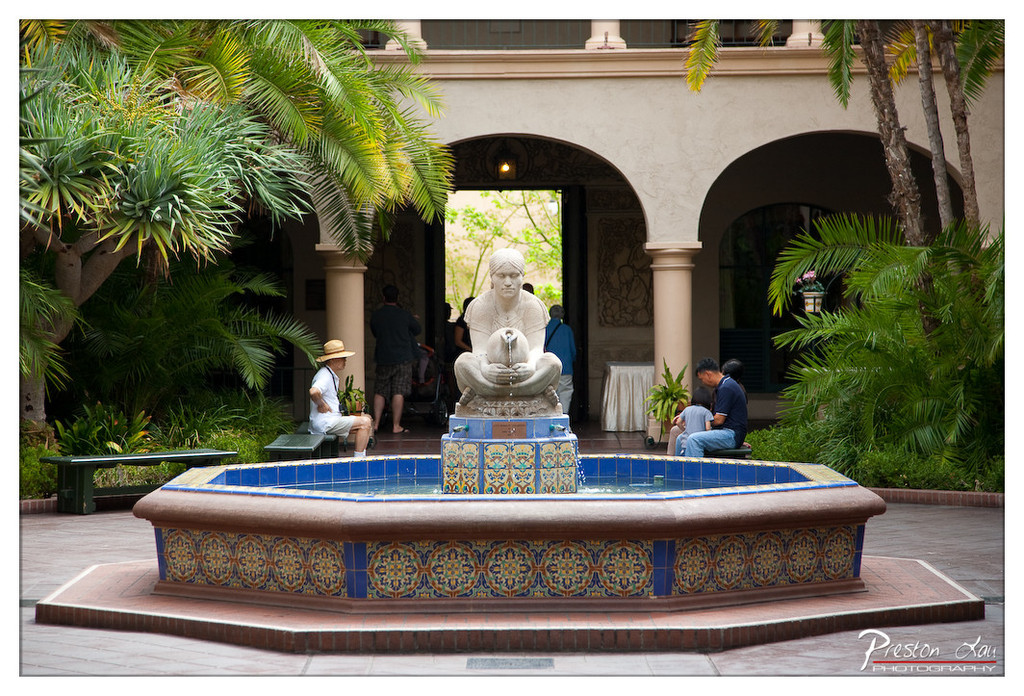

Courtyard Contemplation
Rating: 8/10
Welcome to the tranquil hub of this delightful courtyard, where the main attraction is a rather thoughtful-looking stone figure pouring water endlessly from a pot into a vibrant, tiled fountain. It's the kind of place where time seems to slow down, inviting weary travelers (and perhaps a few strategically placed locals for scale) to just sit and ponder. The mood is undeniably peaceful, a serene oasis away from the hustle and bustle, perfect for practicing your zen... or just deciding where to grab lunch next. Notice the individual on the bench, looking deep in contemplation under his straw hat – perhaps he's solving the world's problems, or maybe just enjoying the splash of the water.
From a photographic perspective, this shot screams classic composition: a strong central subject anchored by that photogenic fountain, nicely framed by the architecture and lush palm fronds acting as nature's vignette. The lighting is gentle, likely overcast or late-day, highlighting the textures of the stone and tiles without harsh shadows – a photographer's dream unless you were *trying* for dramatic chiaroscuro (and let's be honest, who needs that when you have such lovely tiles?). The color palette is a winning combo: warm building tones and cool water blues contrasting with the lively greens. Plus, strategically placed humans on benches add context and prevent the scene from feeling like a ghost town, proving that sometimes, people *do* improve the photo. This composition uses the architectural elements, like the arches in the background with their subtle carvings, to add depth and a sense of place, making it more than just a picture of a fountain.
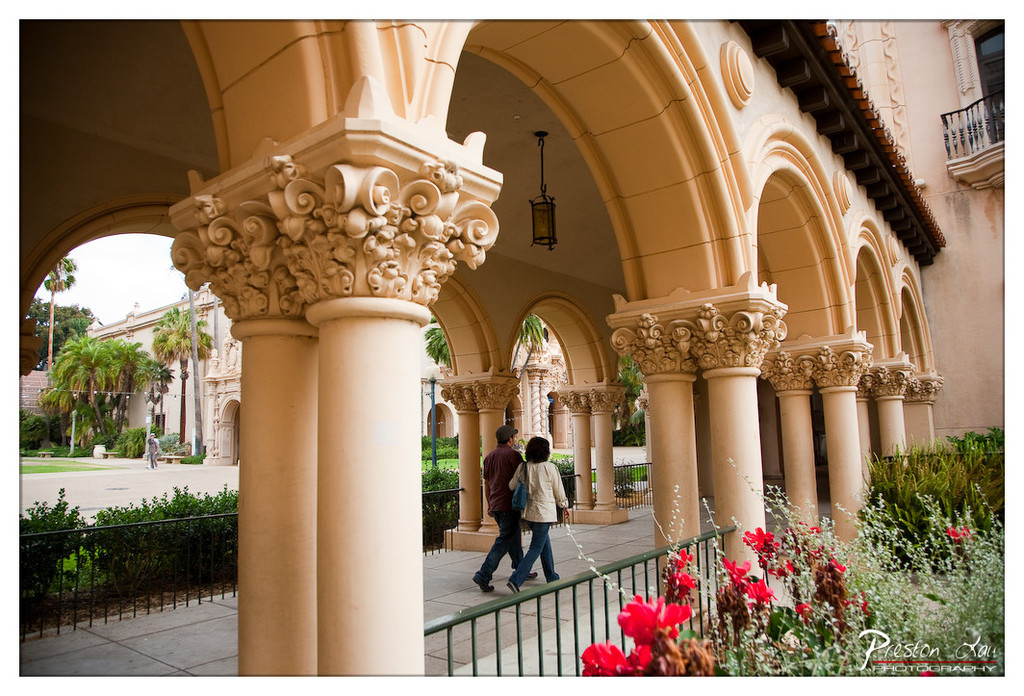

Title: Arches, Amblers, and Architectural Adoration
Rating: 7/10
This image transports us under a magnificent arcade, where ornate, beige columns topped with incredibly detailed capitals frame a view of a sun-dappled courtyard. The subject is undeniably the stunning architecture, a solid 7/10 for its grandeur and intricate detail, though the two figures strolling through add a touch of human scale and narrative (perhaps they're discussing the structural integrity of the arches, or more likely, where to find the nearest restroom). What's happening is a peaceful saunter, bathed in soft, diffused light that flatters the stonework. The mood is one of serene elegance and historical resonance, making you want to linger and admire the craftsmanship, perhaps while pretending to be a character in a period drama.
From a photographer's perspective, the composition uses the repeating arches effectively to create depth and lead the eye into the scene. The foreground railing and vibrant red flowers offer a nice pop of color and texture, preventing the image from feeling too flat, although the flowers slightly obscure the lower part of the first column, which is a minor quibble. The lighting is superb, showcasing the intricate carvings without harsh shadows, suggesting either fortunate timing or skillful light management. The warm color palette enhances the classic feel of the architecture. It’s a well-executed shot that captures the beauty of the location, balancing the grand structural elements with the human presence effectively.
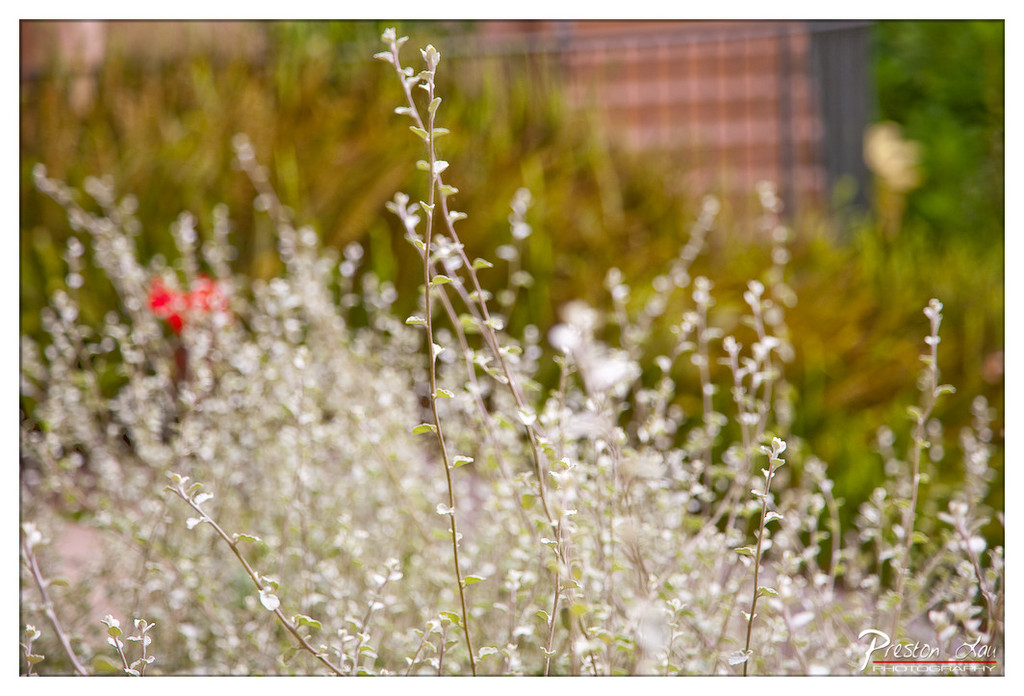

Title: The Chosen Stem Amidst the Bokeh Garden
Subject Rating: 6/10
Here we have a tranquil scene in a garden, where the photographer has decided to give a single, slender stem its moment in the spotlight, while everything else is rendered into a dreamy, impressionistic blur. The foreground is a sea of soft grey-green stems and tiny leaves, out of focus to varying degrees, creating beautiful bokeh spheres that sparkle like distant fairy lights. Behind this delicate chaos, we can vaguely discern the background: a vibrant blur of green and yellow foliage, a hint of a red flower like a shy guest at a party, and further back, the muted tones of a brick wall and a fence providing structural context, albeit a very fuzzy one. The overall mood is one of gentle serenity and perhaps a touch of botanical introspection, contemplating the importance of one stem among many.
From a photographer's perspective, this shot is all about that super-shallow depth of field – a technique that screams "Look only here!" The composition uses the blurry plants in the foreground to frame the slightly sharper stem, drawing the eye effectively. The lighting is soft and diffused, perfect for highlighting the subtle textures of the plant without harsh shadows. The color palette is dominated by soft, desaturated greens and browns, with that single, bold red splash in the background acting as a cheeky counterpoint, proving even blurs can be dramatic. It's a classic example of using bokeh not just as a background blur, but as a significant visual element that adds texture and atmosphere to the image, transforming a simple garden scene into something more ethereal and focused on the micro-details.
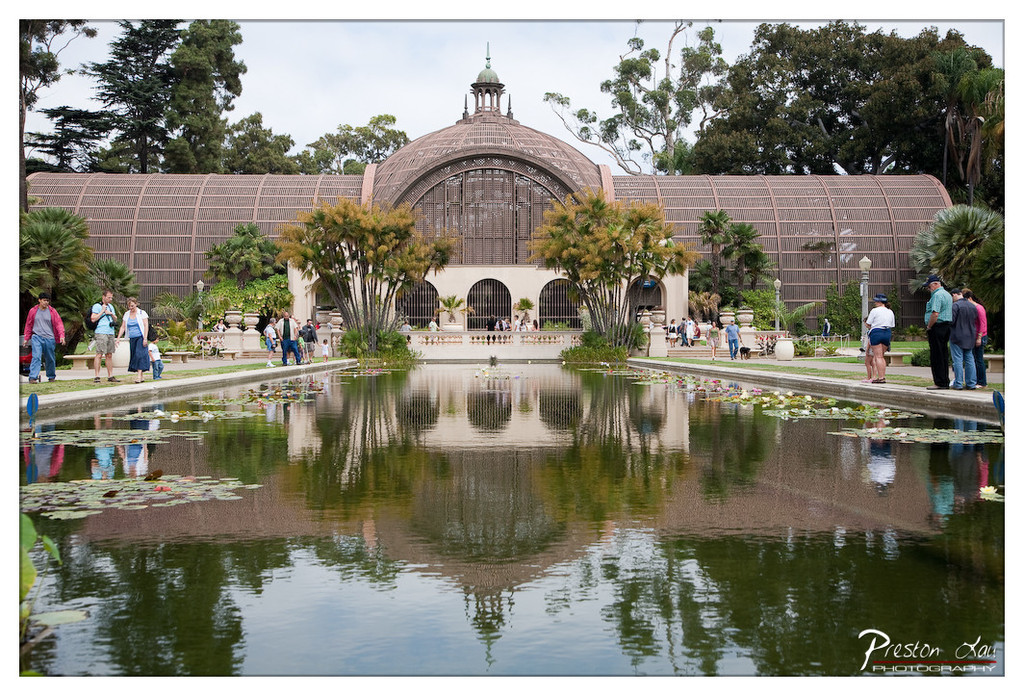

Balboa Park's Grand Reflection
Subject: 9/10
Stepping into this frame is like entering a postcard of San Diego's Balboa Park, showcasing the magnificent Botanical Building and its equally famous reflection pond. The subject itself is a stunner (Subject Rating: 9/10, because it's hard to beat grand architecture and greenery), with people leisurely strolling around the edges, soaking in the atmosphere, and likely contemplating the perfect selfie angle. The mood is distinctly peaceful and relaxed, embodying a classic park day where the biggest decision is whether to admire the building or the lily pads. It's a scene that feels timeless, a perfect blend of human activity and natural/architectural beauty.
Photographically, this shot is a strong demonstration of using reflection for impact, creating a near-symmetrical composition that doubles the visual weight of the stunning dome and facade. The lighting is soft and even, likely a slightly overcast day, which is fantastic for detail and color saturation, preventing harsh highlights and shadows. The color palette is rich with natural greens from the extensive foliage and the pond itself, contrasted with the warm tones of the building. While the reflection isn't perfectly still, the ripples and lily pads add a natural texture that prevents it from looking *too* manufactured, proving that even in classic scenes, a little imperfection can add charm. It’s a well-executed composition that captures the essence of the location effectively.
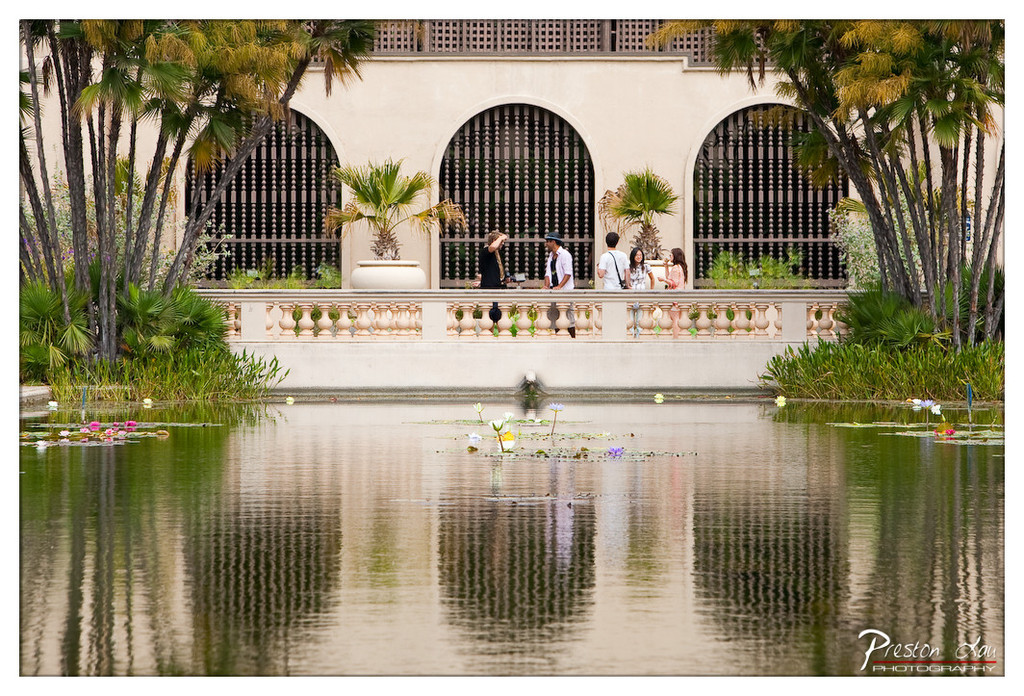

Title: Reflections on a Tranquil Afternoon
Subject Rating: 7/10
This shot captures a peaceful scene, almost serene, featuring a lovely architectural structure with ornate arches and lattice screens overlooking a tranquil pond. A small group of people stands casually on a balcony, adding a human touch to the otherwise static environment, perhaps debating the merits of different lily pad varieties or just enjoying the view. The lush palm trees and greenery provide a vibrant frame, while the still water below beautifully mirrors the building and sky, creating a captivating reflection that doubles the visual interest. The overall mood feels leisurely and calm, like a perfect spot to escape the hustle and bustle.
From a photographic perspective, the composition uses the strong lines of the building and railing, balanced by the organic shapes of the trees and pond. The reflection is a highlight, showcasing impressive clarity – seriously, that water is putting some photographers' focus skills to shame! Lighting is soft and even, which prevents harsh shadows but perhaps makes the scene feel a tad flat, lacking dramatic contrast. The color palette is pleasant, dominated by soft beiges and greens with subtle pops from the water lilies. The people, while adding life, feel a little like props placed just so, standing rather stiffly on the balcony. One person seems engrossed in their phone - a modern touch in this classical setting. The prominent signature reminds us who's responsible for this moment of reflection (both literally and figuratively). While the elements are well-captured, a touch more dynamic lighting or a clearer focus on the human subjects could elevate it further.
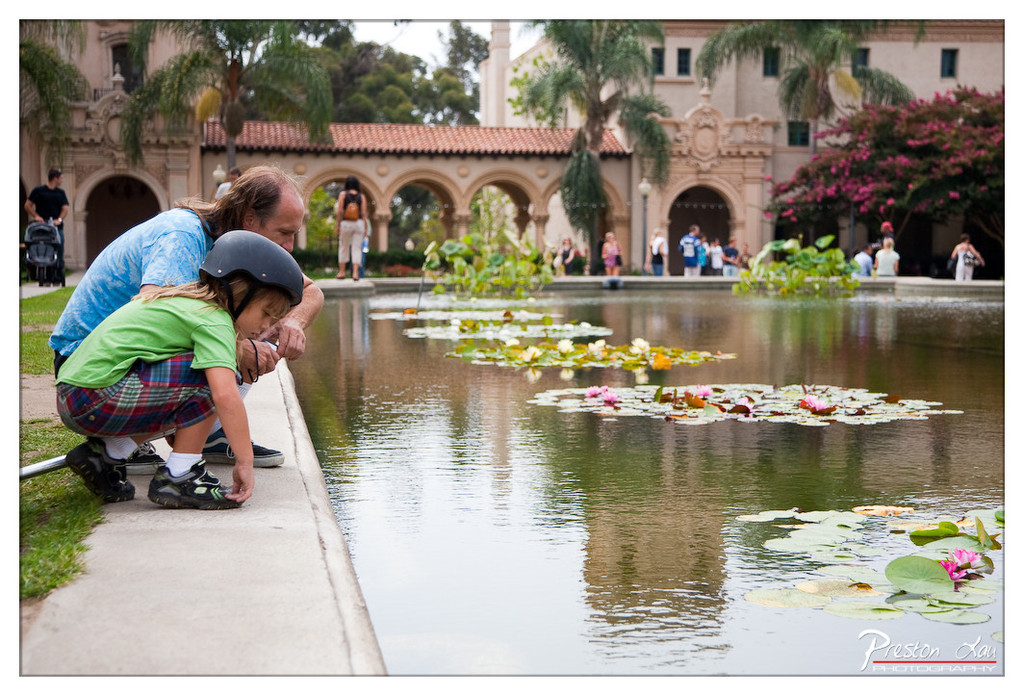

A Shared Pondside Moment
Subject Rating: 9/10
This heartwarming image captures a quiet moment between a father and child peering intently into a pond filled with vibrant water lilies. The child, sporting a cool black helmet and wonderfully patterned plaid shorts, kneels beside the father, who leans forward with a focused gaze. They appear completely engrossed in whatever wonders lie just below the surface, be it fish, insects, or perhaps just the mesmerizing reflections. The mood is one of peaceful curiosity and connection, a little pocket of intimacy amidst the grandeur of the background scene – a large, Spanish-inspired building with arched walkways bustling with other park-goers. The pond acts as the central stage, reflecting the architecture and sky, while the lilies add splashes of cheerful pink, yellow, and white across the surface.
From a photographer's standpoint, the low angle is a clever choice, placing the viewer right alongside the subjects and emphasizing their focused perspective. The composition uses the edge of the walkway and the water line effectively, creating a strong diagonal and horizontal lines that lead the eye into the scene. The lighting is soft and natural, avoiding harsh shadows and beautifully illuminating the subjects and the colorful lilies. The depth of field is shallow enough to blur the background people and building slightly, drawing attention to the foreground interaction and the pond life, yet still keeping the architectural context visible. It's a well-executed candid shot that successfully captures a genuine moment of shared discovery in a visually rich environment. The watermark is tastefully placed, although one might debate its exact position depending on desired print crops, but that's just photographer nitpicking!
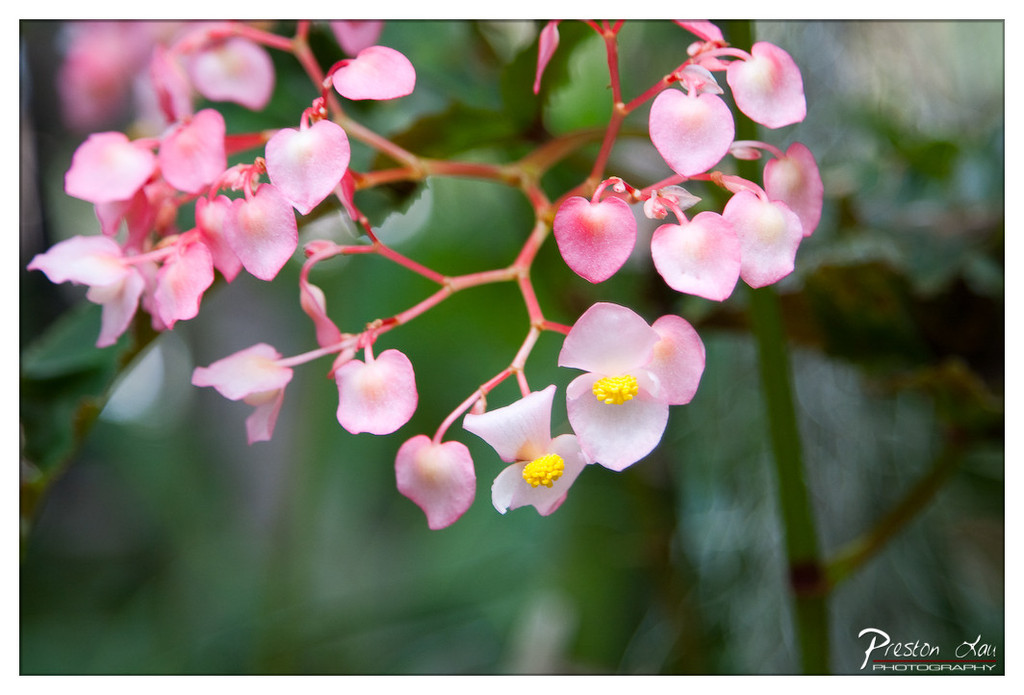

Title: Begonia Hearts and Petal Puffs
Rating: 8/10
Well, if your love life needed a botanical representation, these delicate pink Begonia flowers might just be it! The main subjects here are clusters of heart-shaped pink petals on slender, reddish stems, rating a solid 8/10 for their charming form and lovely color. It looks like a full bloom is underway, with various stages of flowers presented, from tightly closed buds to open blossoms revealing bright yellow centers. The mood is undeniably soft, gentle, and a bit whimsical, like nature decided to have a sweet moment just for this photo. It's a simple scene, yet effective in capturing the fragile beauty of these flowers.
From a technical perspective, the composition uses the diagonal line of the stems effectively to draw the eye through the frame and focus on the main cluster of blooms. The lighting appears soft and diffused, which is perfect for highlighting the subtle variations in the pink petals without harsh shadows – a smart choice for floral photography. The color palette is dominated by soft pinks and various shades of green in the background, creating a pleasing, natural harmony. The shallow depth of field creates a lovely bokeh effect, blurring the background into soft shapes and colors, making the delicate flowers really pop. It's a classic approach for isolating a subject and works well here, though trying to get *all* the little heart-shaped petals perfectly sharp while maintaining that bokeh can be a fun, focus-pulling challenge, as any macro or telephoto floral shooter knows! The dark green foliage in the background provides just enough contrast to make the brighter pink flowers stand out without being distracting.
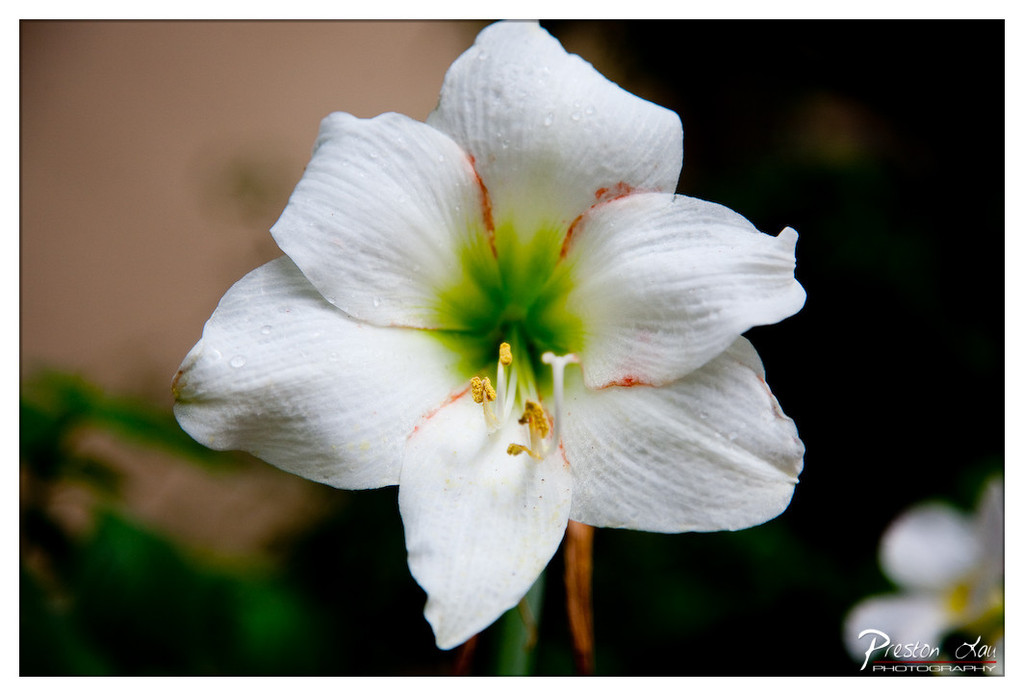

Pristine Amaryllis Bloom
Rating: 9/10
Ah, the classic white Amaryllis, looking all pure and proper, like it just stepped out of a spa treatment. This lovely bloom takes center stage, its six ruffled petals spread wide, each adorned with delicate veins and, adding a touch of natural sparkle, a few precious water droplets. The star of the show isn't just the white; peer into its heart, and you're greeted by a vibrant splash of lime green fading into a soft yellow, where the pollen-dusted stamens stand tall, ready for their moment. There are also these subtle, almost blush-like reddish streaks running up the petals, adding just a hint of drama to the otherwise pristine appearance. It's a beautiful, focused portrait of floral elegance, sharp where it needs to be, letting you appreciate the intricate details of nature's design.
From a photographic standpoint, the composition is pleasingly centered, putting the flower firmly in the spotlight. The lighting is soft, highlighting the texture of the petals and making those tiny water droplets pop like miniature diamonds. The color palette is kept simple, allowing the white and green to truly stand out against the background. Speaking of the background, it's beautifully blurred (hello, lovely depth of field!), transitioning from a warm, earthy brown/green on the left to a mysterious, almost black void on the right. This contrast really makes the bright flower jump off the screen. It's a clean, almost minimalist style, letting the subject shine. The little out-of-focus bloom and the photographer's watermark in the bottom right add a touch of context, grounding this ethereal beauty in the real world. Overall, a well-executed close-up that says, "Look at me, I'm fabulous and just had a shower."
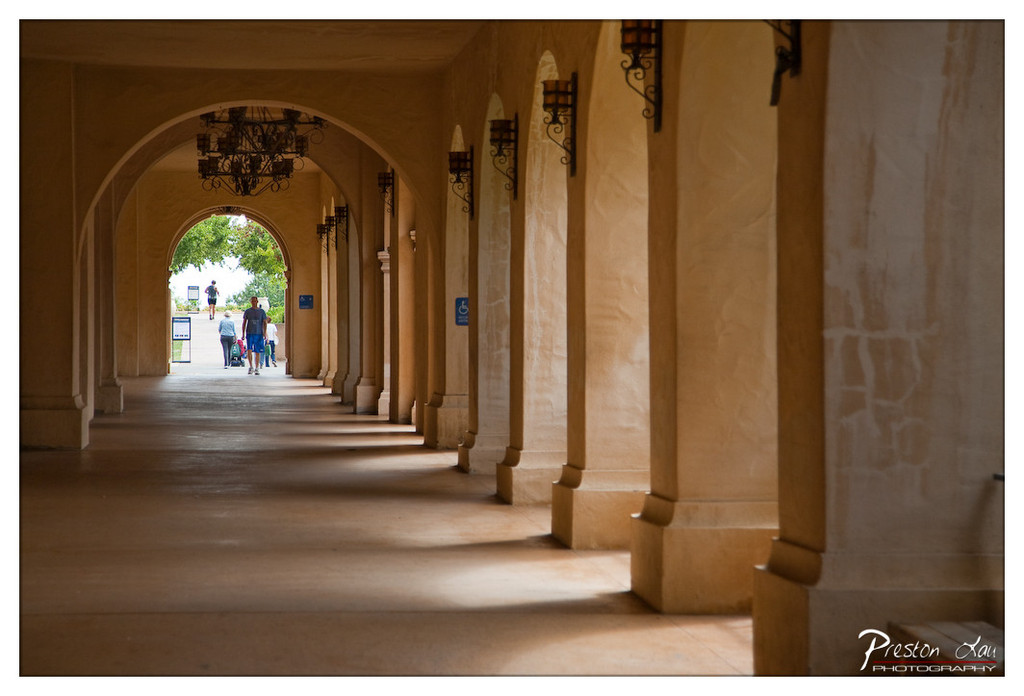

Passage to the Sun
Rating: 8/10
This image transports you into the cool, shaded embrace of a beautiful arched hallway, offering a captivating view towards a sun-drenched world outside. The perspective is deep and inviting, with a series of massive columns and graceful arches lining the path and casting long, dramatic shadows across the warm-toned floor. At the end of the architectural tunnel, a bright opening reveals a glimpse of the outdoors – green trees swaying, a clear sky, and small figures of people meandering up a gentle slope, seemingly drawn by the promise of light and open space. The overall mood is one of tranquil transition, a journey through time or space from the contained interior to the expansive exterior.
From a photography perspective, this shot is a masterclass in using architecture for composition. The photographer has expertly leveraged the repeating arches and pillars to create powerful leading lines that draw the eye straight through the scene to the focal point of the exit. The lighting is particularly effective; the strong natural light flooding in from the end creates a beautiful high-contrast scene and highlights the texture of the stone and plaster. While not quite Rembrandt, the play of light and shadow is certainly compelling, adding depth and drama. The warm, earthy color palette is consistent and pleasing, enhancing the feeling of stepping into a historical or welcoming place. The use of a slightly shallow depth of field, which softens the background figures just enough, helps emphasize the architecture in the foreground while still providing context and scale. It's a well-executed shot that marries strong composition with effective lighting and color.
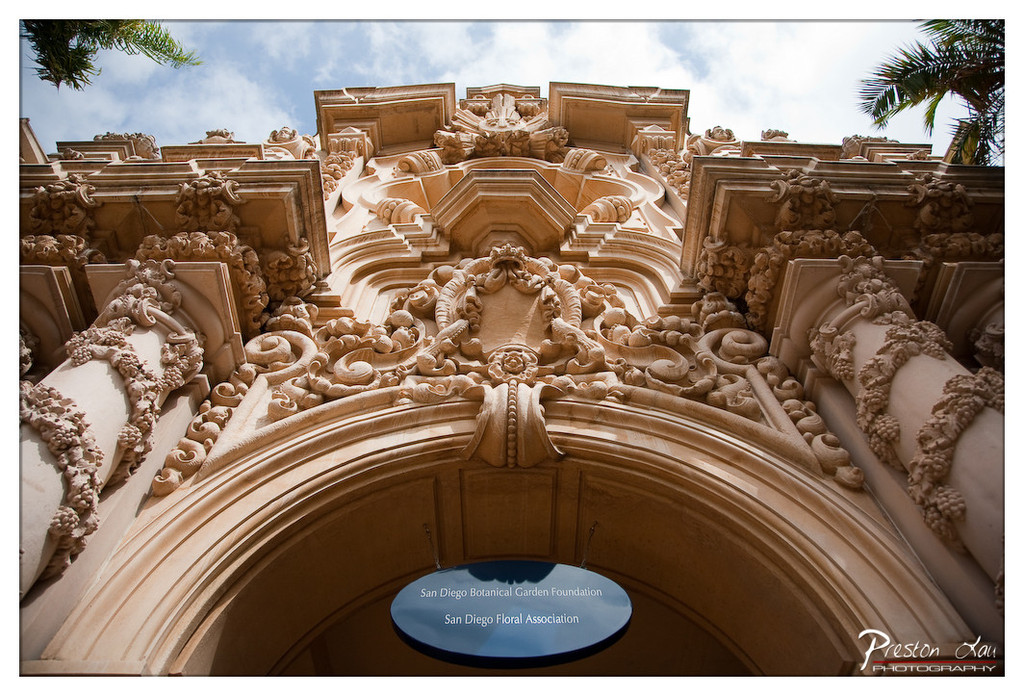

Architectural Flourish
Subject Rating: 8/10
This photo takes a dramatic low angle, looking straight up at the incredibly ornate details of an archway entrance. You can almost feel the weight of the stone above as you gaze upon a riot of carvings: intricate vines, bunches of grapes, swirling acanthus leaves, and some rather stern-looking mythical beasts protecting a central crest. It's the kind of architecture that makes you think the stonemasons were paid by the detail. Below the arch, a modern blue sign, a practical concession to the 21st century, announces the presence of the San Diego Botanical Garden Foundation and the San Diego Floral Association. Framing the sky above, snippets of palm trees add a touch of the local climate to this display of historic grandeur. The overall mood is one of impressive craftsmanship and historical weight, albeit with a modern practical twist.
From a photographic perspective, the low-angle composition is effective at highlighting the imposing height and intricate ceiling of the arch, although it does create some perspective convergence. The lighting appears to be bright daylight, which beautifully illuminates the carvings and reveals their texture and depth without harsh shadows, perfect for showing off every little detail. However, slightly more dramatic side lighting could have enhanced the sculptural quality even further. The warm tones of the stone dominate the color scheme, providing a rich contrast against the cooler blue of the sign and the sky. It's a challenging shot to capture the full scope of detail while maintaining composition, and while the framing here puts the focus squarely on the decorative elements, the slightly cut-off palm trees are a minor distraction in an otherwise detailed study of opulent architecture.
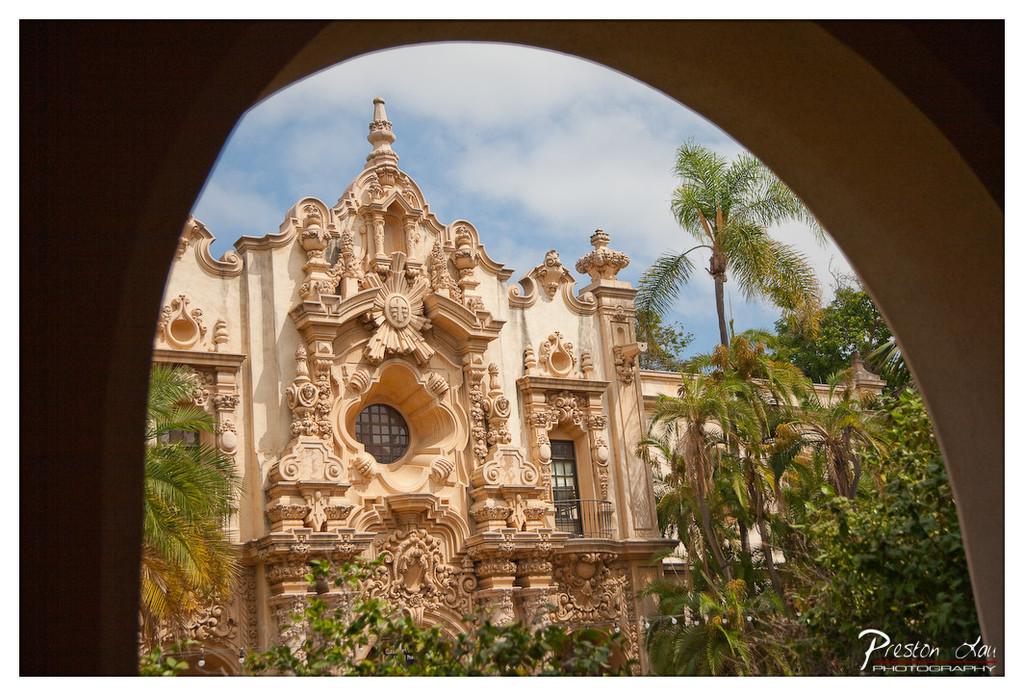

Balboa Park Beauty Through the Archway
Subject Rating: 9/10 - This building is practically screaming "Look at me!" with all that glorious detail. Peeking through a shadowy arch, we're treated to a sun-drenched view of an incredibly ornate facade, likely in Balboa Park, San Diego, given the architectural style and the presence of palm trees. The building is the undisputed star, boasting layers upon layers of sculpted stone, intricate windows, and decorative spires that look like they took a small army of artisans centuries to complete. It's a grand, almost theatrical scene, bathed in warm light that highlights every curve and flourish. The palm trees add a touch of exotic flair, reminding us that this architectural masterpiece isn't lost in some stuffy European city, but is living its best life under the Californian sun.
Compositionally, the photographer has cleverly used the dark archway as a natural frame, directing the eye straight to the magnificent building and creating a pleasing vignette effect. It's like a little window revealing a hidden treasure. The bright sunlight creates dramatic highlights and deep shadows, really emphasizing the three-dimensional relief of the facade – great for showing off all that detail! The color palette is warm and inviting, dominated by the creamy tones of the building against the vibrant green foliage and blue sky. While the dark arch adds drama, the busy foreground foliage on the left could be a minor distraction, but hey, sometimes nature insists on being part of the show. Overall, it's a classic architectural shot with a framed perspective, making this historical subject feel both grand and slightly secretive. And yes, the "Preston Lau Photography" watermark is making sure you know who captured this slice of sunny grandeur.
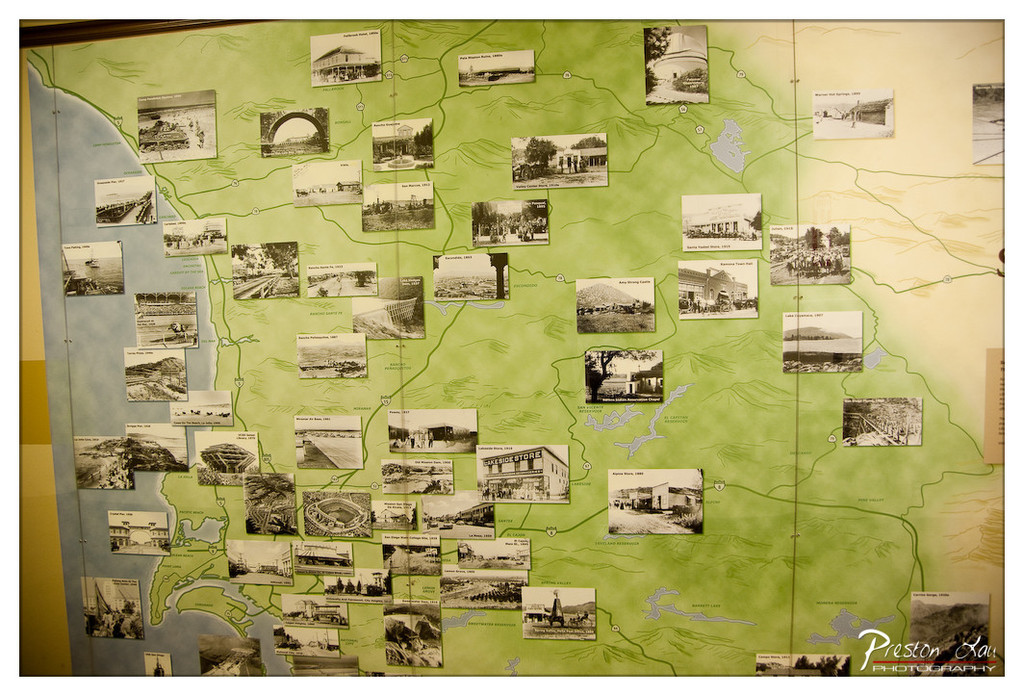

Historical Photo Scatter-Plot on a Map
6/10
This photograph showcases a large, green and blue map, seemingly depicting a region in Southern California, serving as an unconventional backdrop for a multitude of historical black and white images. These photos, varying in size and orientation, are haphazardly placed across the map, loosely correlating to the geographical locations they portray. It's less of a meticulously curated exhibition and more like a visual explosion of the past, where vintage snapshots of buildings, landscapes, and people interrupt the planned routes of highways and the flow of rivers. The overall mood leans towards a nostalgic exploration, offering fascinating glimpses into the area's history, but the sheer volume and cluttered arrangement create a somewhat chaotic, albeit intriguing, historical collage.
From a photographic perspective, the composition is slightly tilted, giving the shot an informal, almost documentary feel, as if the photographer quickly captured the display. The lighting appears flat and even, likely from overhead, which helps illuminate the entire map but does little to add depth or dimension, resulting in some minor glare on the surfaces of the photos. The color palette is dominated by the greens and blues of the map contrasted with the stark black and white of the historical images, which visually emphasizes the time difference but contributes to the busy feel. While the concept of the display is compelling, the photograph itself, complete with a noticeable watermark, functions primarily as a record of the installation rather than a refined piece of art, missing an opportunity to highlight individual historical gems amidst the visual noise. Perhaps rearranging the photos into chronological order would help, or maybe just giving them a bit more breathing room on the map – history needs space, too!
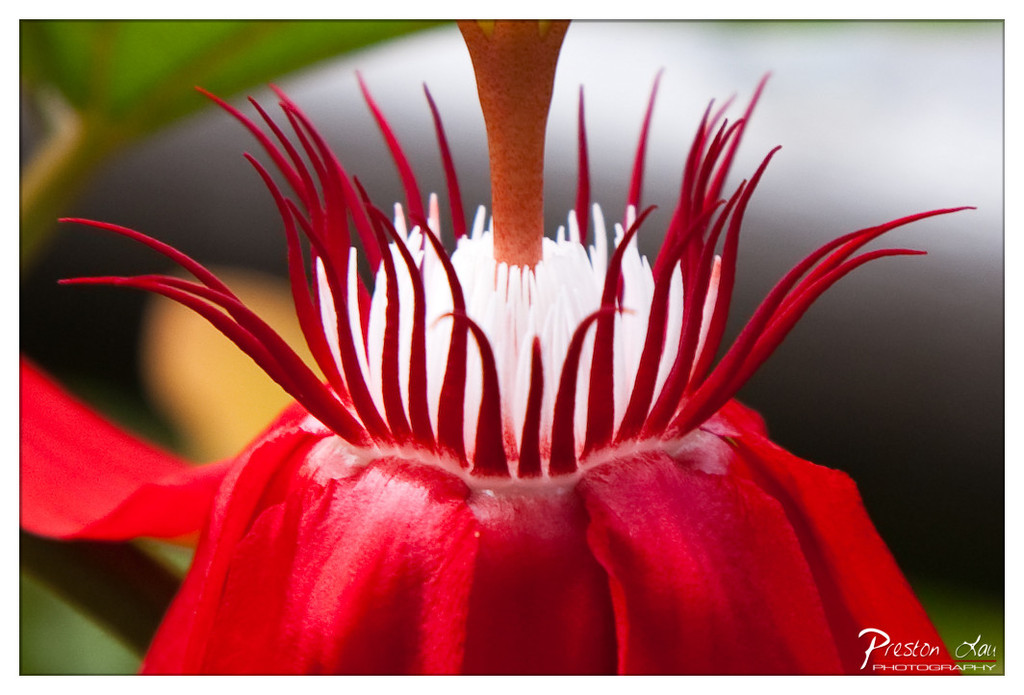

The Spiky Heart of Red
Rating: 8.5/10
Behold, the inner workings of a flower that looks like it's simultaneously hosting a rave and trying to look intimidating. This close-up of a vibrant red flower's center, rated a solid 8.5/10, captures a moment of intense floral drama. What's happening? Well, the flower is primarily just existing, but doing so with an alarming number of spiky red filaments erupting around a fluffy white core. The mood is undeniably 'bold and beautiful, don't touch'. We can clearly see the multitude of needle-like red structures, the soft, contrasting white fluff beneath them, and a singular, rather prominent central stalk reaching skyward. The background is doing its job admirably, dissolving into a dark, nondescript blur of greys, greens, and a faint yellow bokeh circle, ensuring the subject remains the absolute star of this botanical show.
From a photography standpoint, this shot is a fantastic example of getting up close and personal. The composition is tight and centered on the flower's intricate core, letting those striking red spikes dominate the frame and create a sense of explosive energy. The lighting appears to be soft but effective, highlighting the textures of the spikes and making the bright white center almost glow. The color contrast between the vivid red, stark white, and muted background is excellent and makes the flower pop right off the screen – perhaps with a slight nudge towards saturation, but it works for the subject's flamboyant nature. This is classic macro photography, employing a shallow depth of field to isolate the subject and draw the viewer's eye directly to the fascinating, almost alien-like details within the bloom. It's less a delicate petal portrait and more a showcase of a flower's wild side.
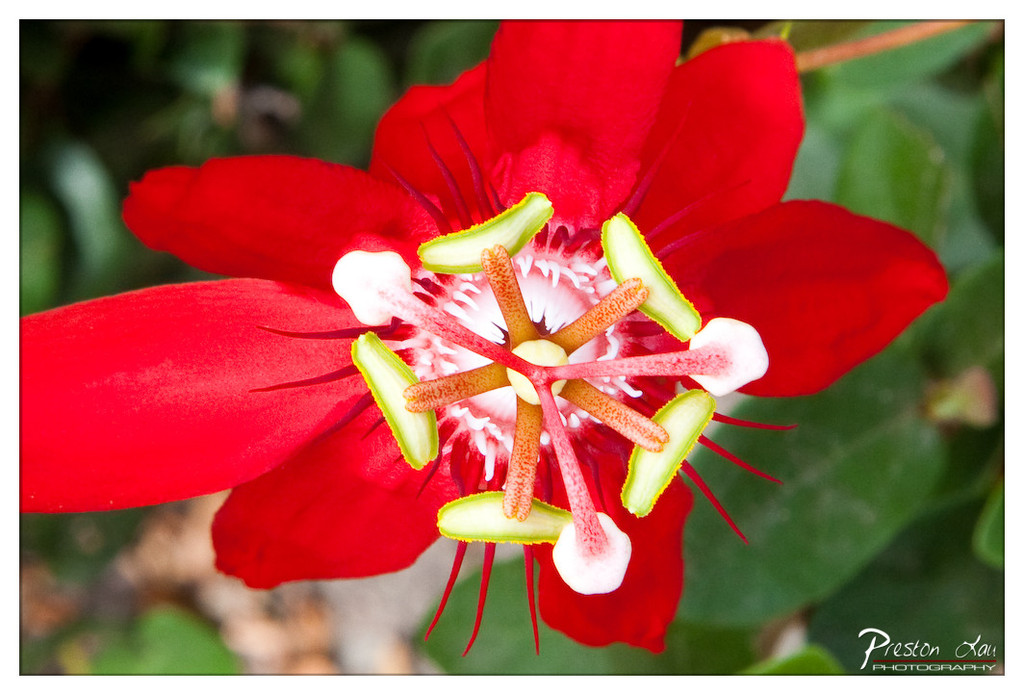

The Alien Architecture of a Passion Flower
Subject Rating: 9/10
Well, hello there, beautiful botanical oddity! This macro shot captures the incredible, almost extraterrestrial, complexity of a red passion flower, specifically highlighting its intricate central structure. Nothing much is "happening" in the action-packed sense, unless you count the flower just being utterly mesmerizing and showing off its geometric prowess. The mood is vibrant and intensely focused, pulling your eye straight into the heart of the bloom, which honestly looks like something designed for intergalactic travel rather than attracting pollinators. It’s a close-up encounter with nature's wild imagination.
From a photography perspective, this is a classic close-up focusing squarely on the main event. The composition is centered enough to show off the radial symmetry of the flower's corona and reproductive parts, though the large red petals provide a dynamic, slightly off-center anchor. The lighting appears to be direct, bright sunlight, which does a fantastic job of illuminating the textures and colors, making that red *pop* like a firecracker. However, it also creates some strong highlights on the white and green parts, suggesting a slightly harsh light source – maybe a diffusion panel would have softened those edges? The colors are rich and saturated, showcasing the deep red petals, the striking green of the unripe fruits (or maybe ovaries?), and the warm orange/brown stamens. The blurred green background provides just enough context without distracting from the star of the show, creating a decent bokeh that isolates the subject effectively. A great capture of a truly unique flower, proving that sometimes, the weirdest subjects make the best photos!
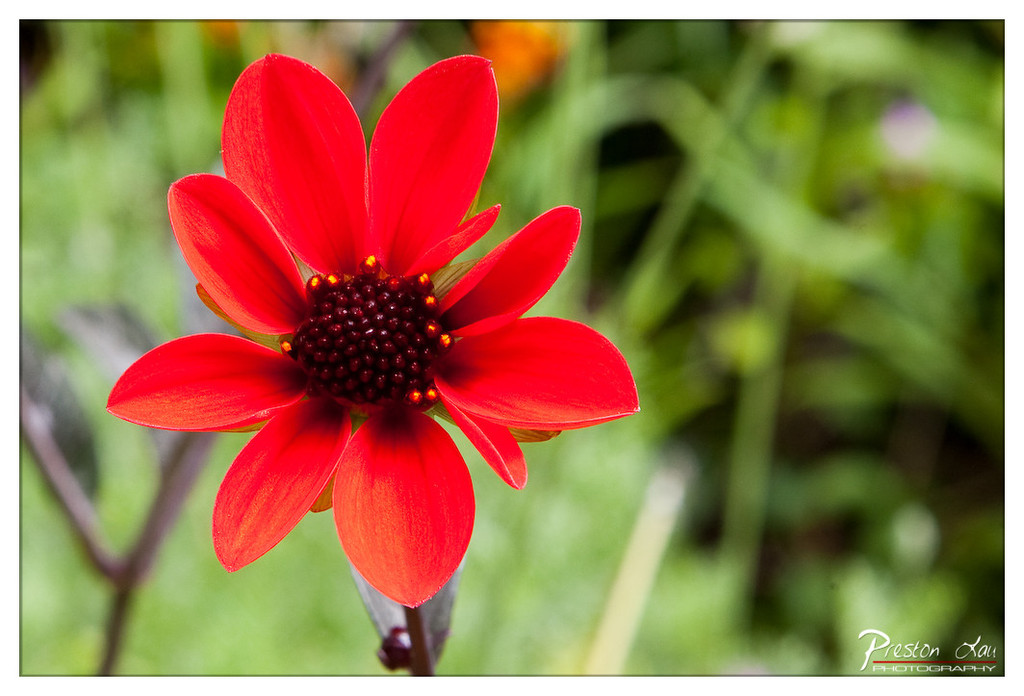

The Red Rebel Against the Green Blur
Subject: 9/10
Wowza, this flower clearly didn't get the memo about blending in. With a Subject Rating of 9/10, this vibrant red specimen dominates the frame like a lead singer hitting a high note. It's less of a 'flower in a garden' and more of a 'RED flower staging a one-petaled protest against the tyranny of green foliage'. The mood is definitely 'Look at me!', radiating energy and passion from its intensely saturated petals and dark, almost velvety center studded with bright little pollen-tipped anthers. It's a confident burst of color against a background that has clearly been told to 'sit down and be quiet' by the photographer and the magic of aperture. You can almost hear it humming show tunes.
From a photographic standpoint, this is a classic execution of subject isolation. The composition places our fiery friend slightly off-center, allowing its glorious form room to breathe while still being the undisputed star. The lighting is spot-on, enhancing the vivid red without blowing out the highlights, and it nicely defines the texture of the petals. But the real MVP behind the scenes? The bokeh! That creamy, dreamy, out-of-focus background turns distracting greenery into a soft, supportive blur, pushing the eye directly to that magnificent red. It shows a clear intent to capture detail and drama, proving the photographer, Preston Lau (as the watermark subtly suggests), knows their way around a shallow depth of field and a flower with star potential.
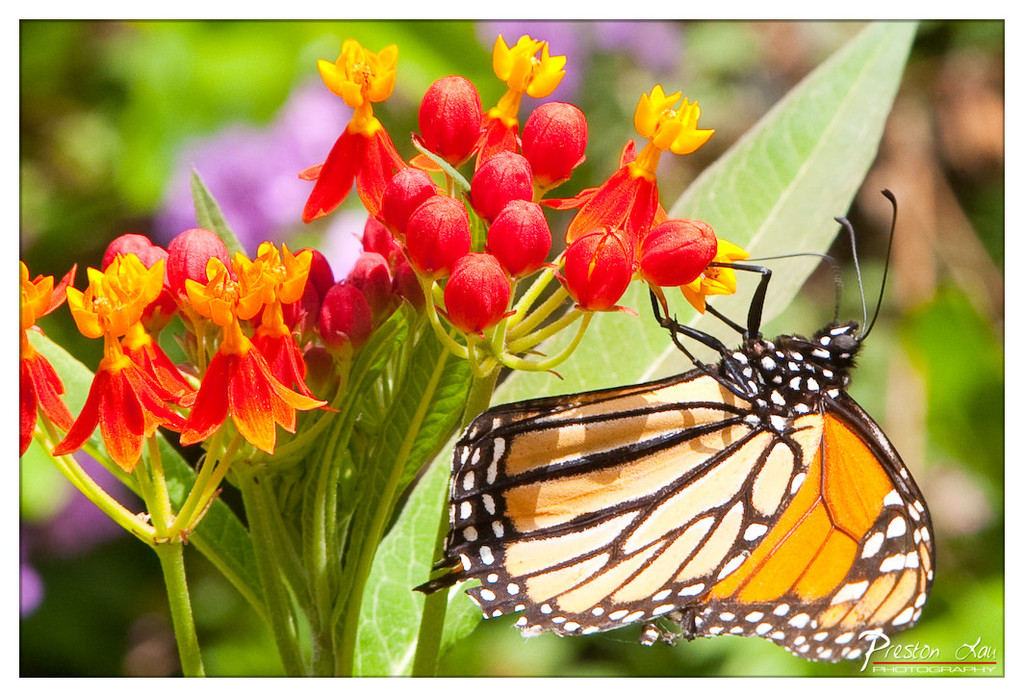

Floral Feast
Subject Rating: 8/10
Here we have a monarch butterfly, our lovely striped subject, settling down for a good long drink on a cluster of exceptionally vibrant red and orange flowers. The butterfly, caught mid-perch, dominates the right side of the frame, with its intricate wing pattern and antennae clearly visible. The flowers on the left offer a juicy-looking buffet of red buds and striking orange and yellow petals, adding a splash of intense color against the softly blurred background of greens and hints of purple foliage. The overall mood is one of lively nature and detailed intimacy, showcasing a small moment in the life of this beautiful insect and its floral host.
From a photography perspective, the detail on the butterfly's wing and head is wonderfully sharp, a testament to precise focusing. The shallow depth of field effectively isolates the subjects from the background, creating a pleasing bokeh that makes the colors pop even more. While the composition features only part of the butterfly, it forces the viewer's eye to appreciate the fine details of its markings and texture – it's a close crop, perhaps a happy accident or a deliberate artistic choice to focus on the essence rather than the whole. The lighting appears bright and natural, bringing out the rich saturation of the oranges, reds, and yellows. Capturing a skittish subject like a butterfly this close is always tricky, proving the photographer's patience or the butterfly's deep commitment to its snack break.
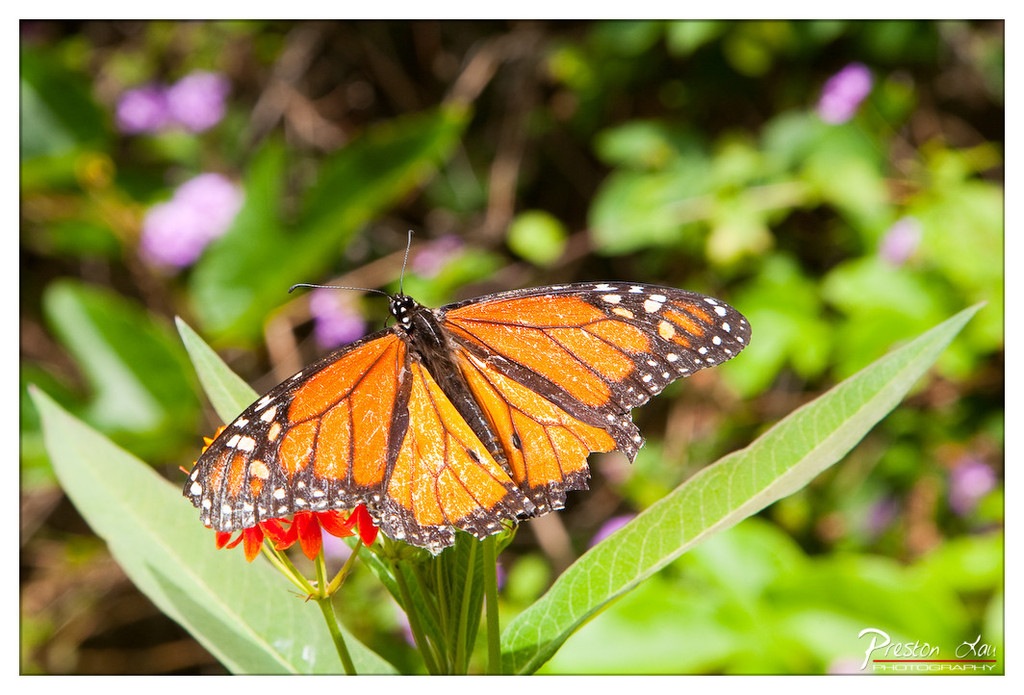

Monarch of the Worn Wing
Subject Rating: 8/10
Here we have a majestic monarch butterfly, though perhaps one who's seen a few too many miles on the migration highway judging by the battle scars on its wings. Perched delicately on a vibrant cluster of small orange-red flowers, this resilient insect seems to be taking a well-deserved nectar break. The background is a soft, dreamy blur of greens and browns, punctuated by hints of purple flowers, creating a beautiful bokeh effect that really makes our slightly-battered hero pop forward. The mood feels natural and a little poignant, highlighting the fragility and endurance of these incredible creatures against the backdrop of a gentle garden scene.
From a photographic perspective, this is a solid capture. The composition places the monarch nicely, allowing the diagonal line of the foreground leaf to lead the eye towards the subject. Focus is critically sharp right where it needs to be – on the butterfly's body and eyes, despite the slightly ragged wing edges. The natural lighting is soft and even, showing off the intricate vein patterns and vibrant orange color of the wings without harsh shadows. The color contrast between the butterfly, the bright flower, and the green foliage is visually appealing. It’s a classic nature shot, expertly executed by Preston Lau, who managed to catch this traveler mid-journey, proving even imperfect subjects can make for compelling images.
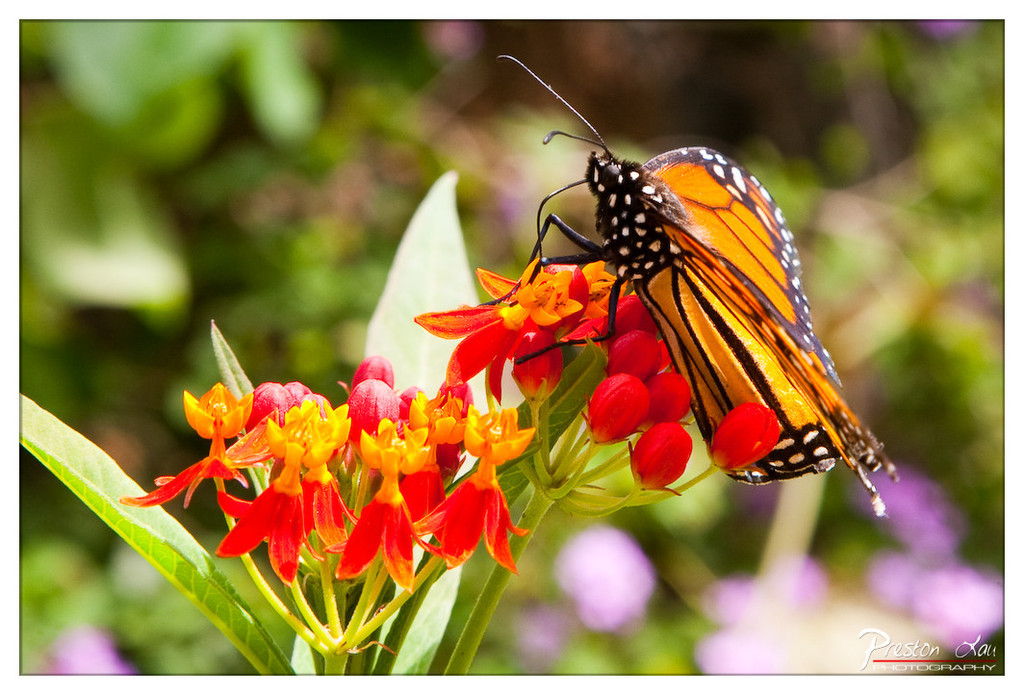

Nectar Feast
Subject Rating: 9/10
This stunning image captures a beautiful Monarch butterfly completely engrossed in feeding from a cluster of vibrant orange and red Milkweed flowers. The butterfly's iconic black-veined orange wings are prominently displayed as it carefully navigates the blossoms, its proboscis extended to sip nectar. The plant itself is bursting with color, featuring both fully open, intricate flowers and plump red buds, all supported by healthy green leaves. The overall mood is one of peaceful natural activity, highlighting the simple beauty of an insect interacting with its food source. The background is a dreamy wash of out-of-focus green foliage with subtle hints of soft purple and pink bokeh, creating a lovely soft separation between the subject and its environment.
From a photographer's standpoint, the composition is quite effective, placing the butterfly nicely within the frame without being dead center, allowing the flow of the flowers to lead the eye. The shallow depth of field is expertly utilized to throw the background into a creamy blur, making the butterfly and the flower cluster truly stand out – it’s bokehlicious! The natural lighting is bright, highlighting the textures on the butterfly's wings and the intricate structure of the flowers. The color palette is incredibly rich and warm, with the fiery oranges and reds contrasting beautifully against the calming green background. It's a classic example of capturing wildlife macro photography, requiring patience and a keen eye for detail. The Preston Lau Photography watermark sits subtly at the bottom right, marking this lovely moment in nature.
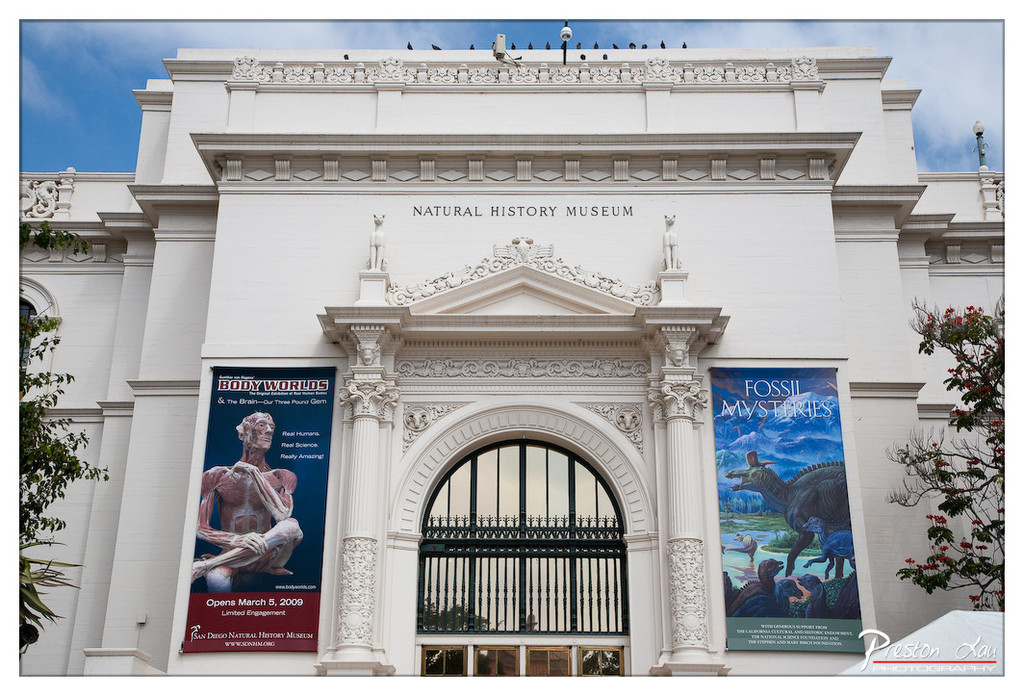

Grand Façade and Ancient Secrets
8/10
Behold, the stately San Diego Natural History Museum, presenting its classic white facade under a benevolent sky. This shot perfectly captures the institution's grandeur, focusing on the elaborate central entrance adorned with intricate carvings, Corinthian columns, and what appear to be majestic cat statues perched regally above the archway – perhaps the museum's feline guardians of knowledge? Large banners announce current attractions: the anatomical marvels of "Body Worlds" and the prehistoric wonders of "Fossil Mysteries," promising a journey through time and biology. The overall mood is one of enduring elegance and intellectual promise, inviting passersby to step through the impressive archway into a world of discovery.
From a photographic perspective, the composition aims for strong symmetry centered on the main entrance, a classic approach for architectural photography. The lighting is quite even, allowing the intricate details of the white building and its decorative elements to be well-rendered without harsh shadows or blown-out highlights. This suggests the light was either soft or diffused, which works well for capturing texture. While the symmetry is intended, there might be a slight vertical skew or perspective distortion, common when shooting tall buildings head-on, that could benefit from correction. The banners, while informative, are slightly tilted and break up the clean lines, adding a touch of candid reality (or just the effects of gravity and wind) to the formal setting. Bonus points for capturing the resident pigeons providing scale and a dash of unintentional comedy on the roofline.
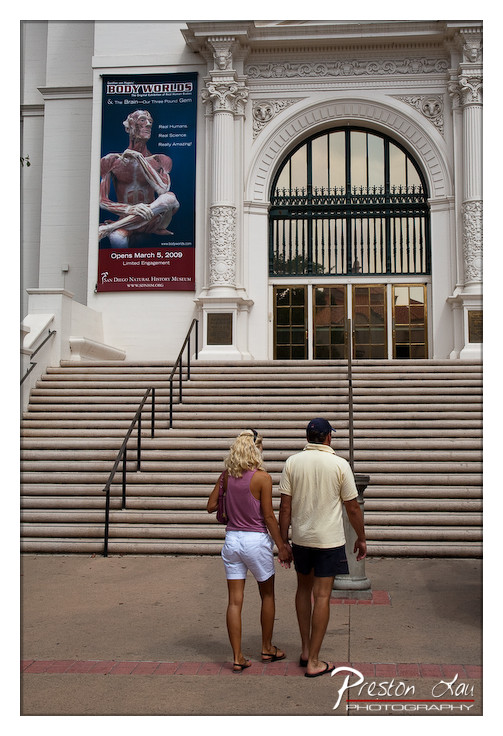

Stairway to Bodyworlds
Rating: 7/10 (for the couple's role in the scene)
Here we have a candid shot capturing a couple embarking on what promises to be a 'really amazing' experience at the San Diego Natural History Museum. They are shown from behind, ascending the grand, wide staircase leading up to the museum entrance. Prominently displayed on the building is a large banner advertising the "BODYWORLDS & The Brain—Our Three Pound Gem" exhibit, featuring a striking anatomical figure and the opening date of March 5, 2009. The building itself is an impressive structure with classical architectural elements, including large columns, intricate carvings, and a large arched window above the entrance doors. The mood is one of straightforward observation; it’s a moment captured in time, slightly mundane yet hinting at the extraordinary science that lies within.
From a photographic standpoint, the composition effectively uses the leading lines of the stairs to guide the viewer's eye towards the building and the exhibition banner, which serves as a key point of interest and context. The couple, placed lower in the frame, provides a sense of scale and humanizes the imposing architecture. The lighting is soft and even, typical of overcast or diffused daylight, which avoids harsh shadows but also results in a somewhat flat image; more dramatic lighting might have enhanced the grandeur of the building. The color palette is dominated by the neutral tones of the stone stairs and building, with the vibrant blue and red of the banner providing a stark contrast, alongside the more subtle colors of the couple's clothing. It’s a competent travel photo, documenting a place and time, though perhaps lacking a strong individual artistic voice beyond clear framing, marked by the photographer's signature watermark. The humor is subtle, relying on the juxtaposition of the detailed anatomical exhibit advertised and the slightly anonymous, rear-view subjects about to enter.
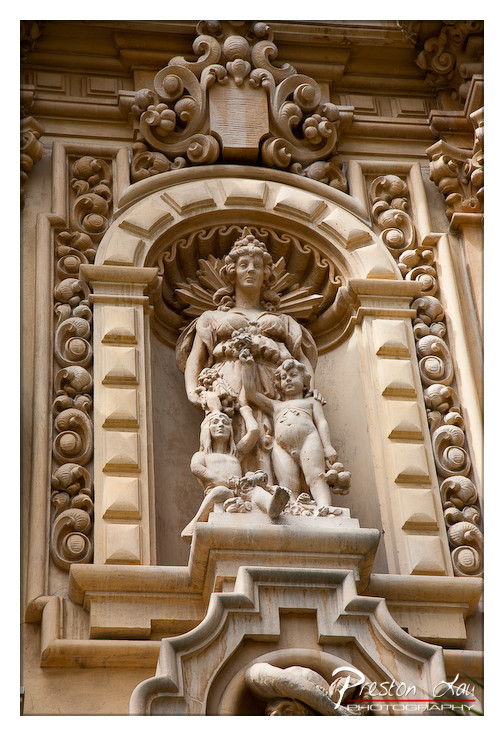

Ornate Architectural Drama
Subject: 8/10
Alright, let's dive into this stone-cold family drama unfolding on a building facade. We've got the central matriarch figure, looking rather stoic (or maybe just suffering from centuries of pigeons), holding a bounty of fruit or flowers. Flanked by what appear to be rather portly, slightly bewildered cherubic figures, one of whom seems to be offering up a cluster of grapes with surprising enthusiasm. Below them, a more reclining figure adds to the slightly chaotic yet clearly deliberate composition. The whole scene is nestled within a fantastically elaborate architectural niche, dripping with ornate carvings – spirals, grapes, little bumps that look like petrified popcorn – all testifying to a time when 'less is more' was clearly not the design philosophy. The mood is certainly grand and historic, maybe a touch melancholic from enduring the elements, like a really old family photo that's seen better days.
From a photography perspective, this is a commendable effort to capture intricate detail under challenging lighting. The composition is a tight crop, focusing entirely on the sculpture and its immediate architectural frame, which works well to isolate the subject and highlight its complexity. The side lighting is a double-edged sword here; it dramatically accentuates the texture and depth of the carvings, bringing out every chisel mark, but it also creates deep shadows and hot highlights. Getting that exposure balance right on such an uneven surface is tricky – hats off for making the main figures legible. The color palette is limited to the warm, earthy tones of the stone, enhanced by the natural light. It's a classic study of architectural photography, capturing the craftsmanship of yesteryear, although the watermark makes it clear this particular piece of history belongs to Preston Lau.
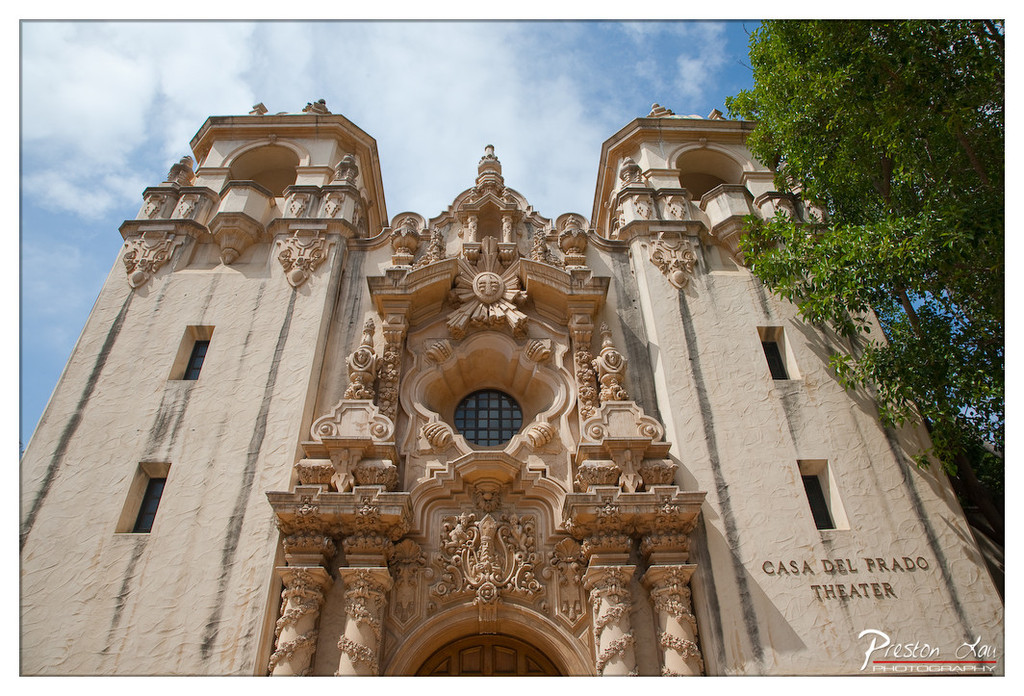

Baroque Belle Reaching for the Sky
Subject Rating: 9/10
This striking photograph captures the grand facade of the Casa del Prado Theater, a magnificent example of Spanish Colonial Revival architecture, likely boasting those wonderfully excessive Churrigueresque details that make you wonder if the architects were paid by the pound of stucco ornamentation. Nothing particularly action-packed is happening here; it's a stately building just being its fabulous, elaborate self under a bright sky dotted with clouds. The tone is one of historic grandeur and maybe a slight feeling of being dwarfed by the sheer scale and decoration from this low perspective. Visible elements include the intricate carvings around the central window and doorway, the symmetrical (almost) towers, small rectangular windows, and the clearly legible "CASA DEL PRADO THEATER" sign, proudly announcing its purpose. A large, vibrant green tree intrudes on the right side, adding a splash of natural color against the building's warm, sandy hue and the blue sky background.
From a photographic standpoint, the low-angle composition emphasizes the height and imposing nature of the structure, though it likely introduces some perspective distortion, making the towers appear to lean back slightly – a common challenge when shooting tall buildings without tilt-shift lenses, or perhaps intentional for dramatic effect! The midday lighting is quite strong, expertly highlighting the deep textures and shadows of the ornate carvings, but also casting some potentially harsh shadows on the left tower face. The color palette is dominated by the warm, sun-drenched stucco, contrasting nicely with the cool blue sky and the green of the tree. The overall style leans towards architectural portraiture, aiming to showcase the building's character and detail, although the inclusion of the tree adds a touch of environmental context, giving it a slightly less formal feel. It's a solid shot that captures the essence of the facade, even if the angle makes you feel like you're craning your neck just looking at the picture.
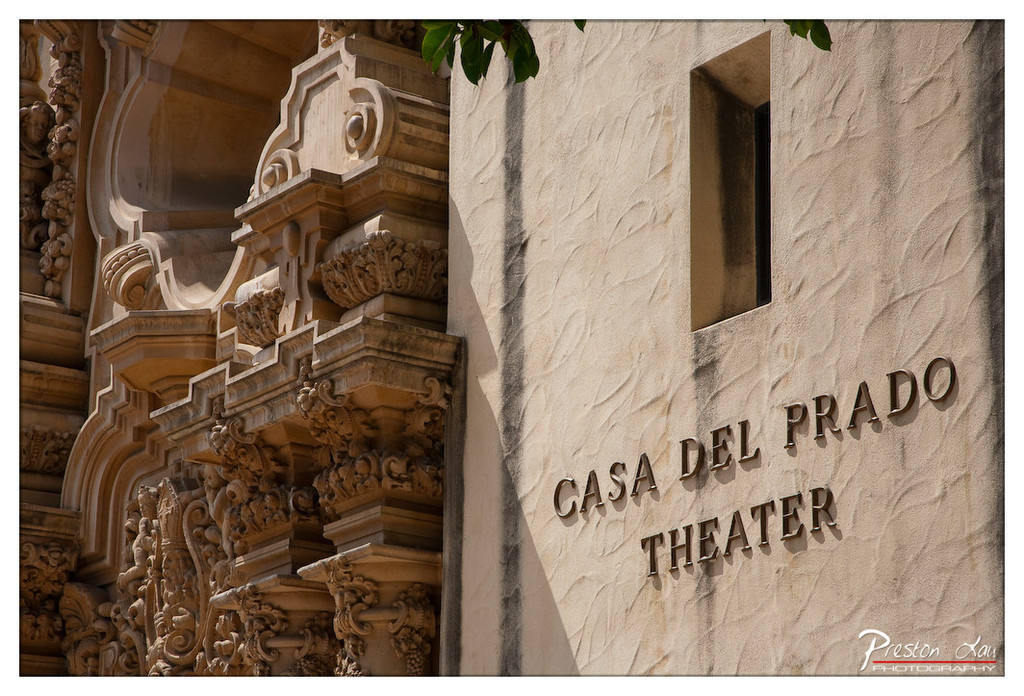

Title: Casa del Prado Theater - Sunny Details
Rating: 9/10
This image presents a focused view of the Casa del Prado Theater building, showcasing a fascinating contrast between highly ornate architectural details and a simpler, textured wall bearing the building's name. The mood is bright and somewhat grand, filled with the energy of a sunny day casting strong shadows that accentuate the building's forms and textures. What's happening is a still moment captured, highlighting the historical character and design elements of the facade. The subject, the architecture itself, is rated 9/10 for its inherent visual richness and the way the light reveals its intricate details, making it a compelling subject for architectural photography.
Compositionally, the frame is split, dedicating the left side to the complex layers of carved stonework and the right side to the more expansive, stuccoed wall. This division works well, drawing the eye across the different surfaces. The lighting is a key element here; strong directional sunlight creates dramatic shadows that give depth and definition to the relief carvings and the raised letters of "CASA DEL PRADO THEATER." This kind of light is fantastic for bringing out texture, making even the seemingly plain stucco appear dynamic. The warm, golden tones of the building material are enhanced by the sunlight, adding to the inviting feel. While the small, dark window on the right feels a bit understated compared to the other elements, it adds a touch of realism. Overall, the technical execution is sound, with sharp focus and good exposure handling the high contrast. It's a well-composed shot that effectively uses light to emphasize the architectural artistry, proudly signed off by Preston Lau Photography.
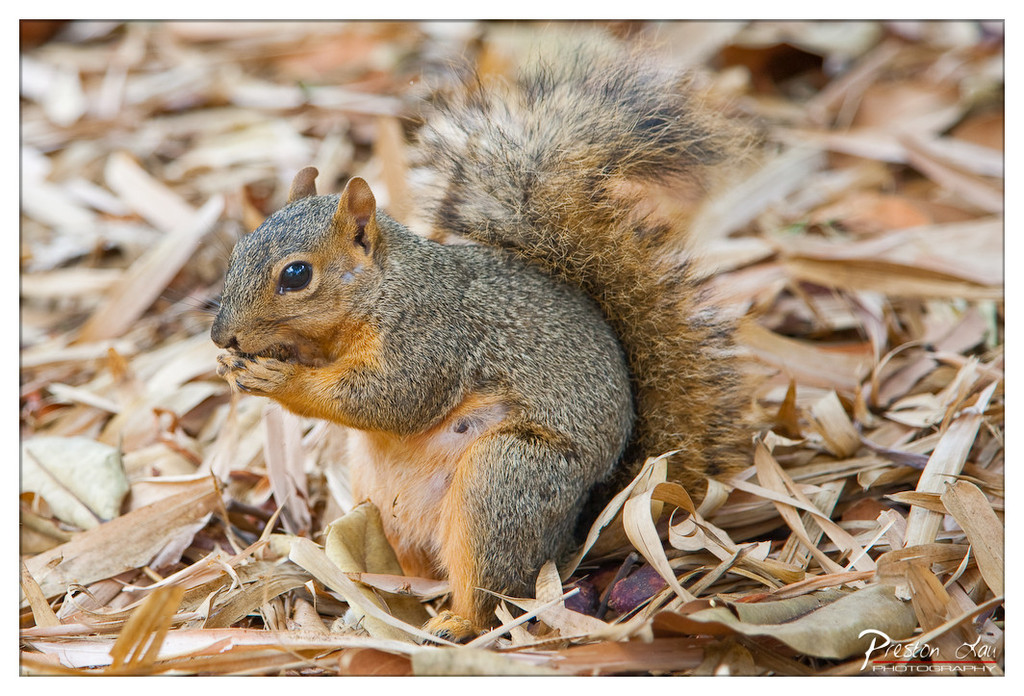

Title: Autumn Snack Time
Rating: 8/10 for sheer squirrelly dedication
This close-up captures a classic backyard drama: a squirrel fully engrossed in the serious business of eating. Our furry protagonist, rated a solid 8 for its captivating combination of bushy tail and snack obsession, is perched on the ground, clutching something unseen but clearly delicious in its paws, looking intensely focused with wide, dark eyes. The setting is a sea of dried, brown leaves and debris, creating a natural, somewhat messy carpet around the creature. The overall mood is one of quiet industry and the timeless ritual of foraging. The style leans towards a naturalistic wildlife portrait, catching the animal in a candid moment.
From a photographic standpoint, the composition places the squirrel slightly off-center, allowing it some breathing room on the left and emphasizing the texture of the leafy environment. The focus is tack sharp on the squirrel's face and body, with the background falling away into a pleasant bokeh, isolating the subject effectively despite the busy surroundings. The lighting appears to be soft natural light, casting warm tones on the squirrel's fur and the dried leaves, enhancing the autumnal feel. The color palette is dominated by browns, grays, and oranges, providing a harmonious, earthy look. While the background texture is interesting, maybe a *slightly* less cluttered patch could have been chosen for even cleaner isolation, but hey, that's nature's dining table! The signature in the corner proudly declares the photographer's capture of this fleeting, nutty moment.
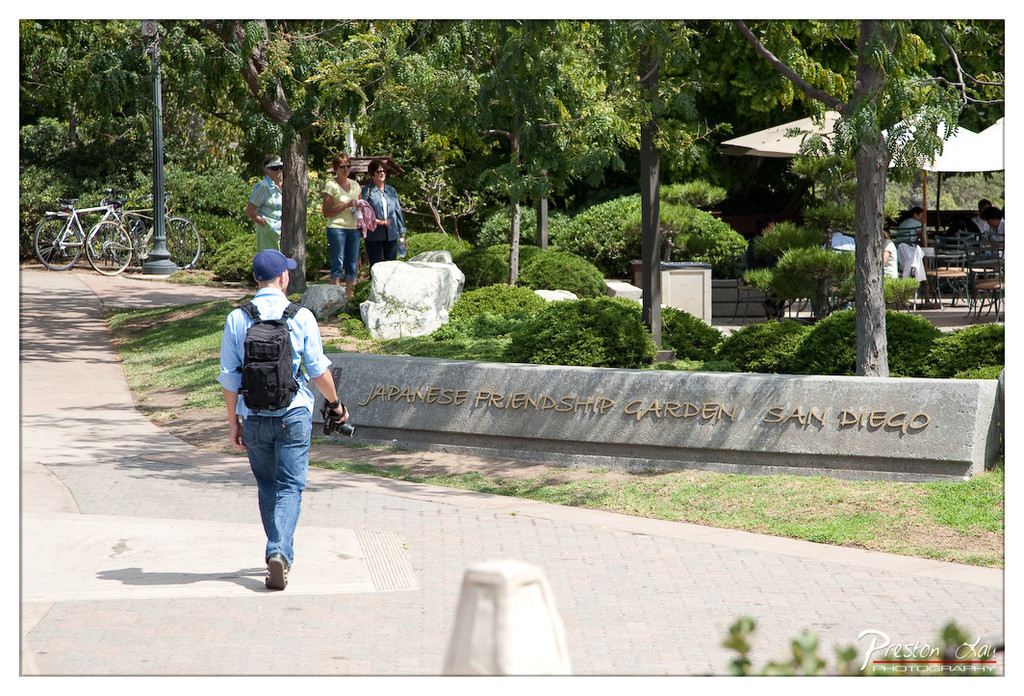

The Lone Walker and the Friendship Garden
Rating: 7/10
This shot captures a moment of potential and transition, featuring a lone figure, complete with the essential photographer's backpack and camera, purposefully walking away from the viewer. He's heading towards the clearly marked "JAPANESE FRIENDSHIP GARDEN SAN DIEGO", a solid, engraved stone sign serving as the main focal point in the mid-ground. The scene is set on a sunny day, lending a bright, leisurely mood to the image, suggesting a pleasant exploration is about to begin. In the background, hints of the garden's lush greenery, rocks, and even a distant cafe under umbrellas are visible, inviting the viewer to follow the walking subject into this serene environment.
From a photographic standpoint, the composition uses the path as a leading line, directing the eye towards the subject and the prominent garden sign. However, having the primary human subject literally walking out of the frame's potential interaction feels a bit like a tease – "Look, a photographer! Now watch him leave." The lighting, while typical for a sunny day, creates some harsh shadows on the path, though the garden area seems to handle the dynamic range well, showcasing the greens effectively. The placement of the sign is strong, anchoring the shot and clearly stating the location, which is essential context. It's a classic travel/documentary approach: show the destination, show someone arriving. Maybe the humor here is that the *photographer* is the subject, and we're left wondering if they got any *good* shots once they actually entered the garden. It's a decent scene-setter, capturing a moment of arrival, but leaves you hoping for the 'after' photos. Also, kudos for the visible camera – just in case we doubted their intentions!
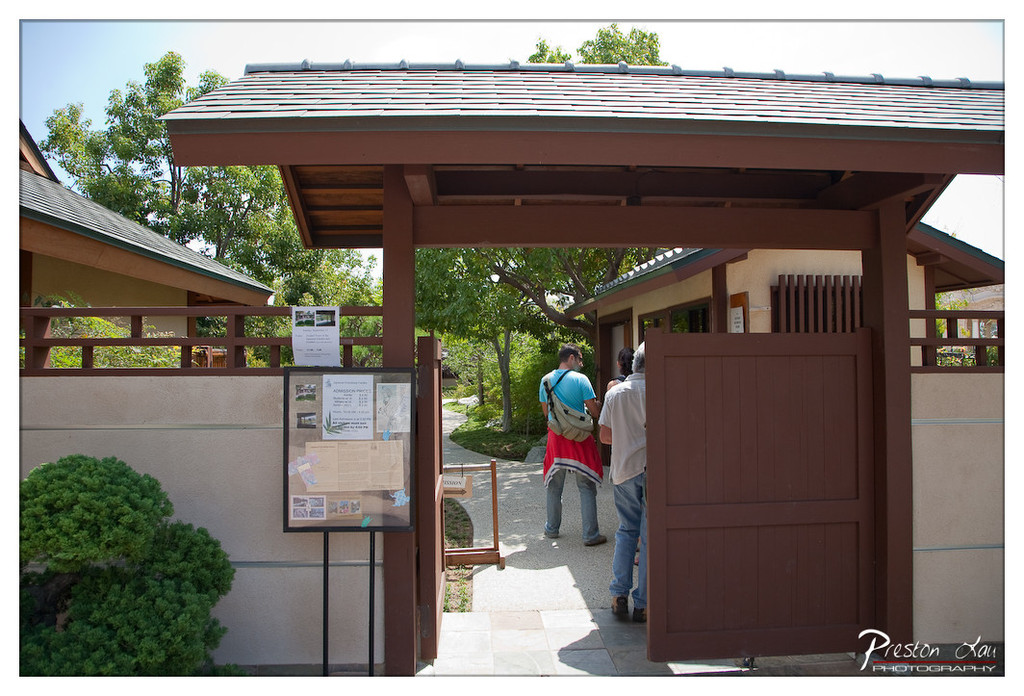

The Partially Welcoming Entrance
Alright, welcome to... somewhere! Looks like the entrance to a Japanese garden or some serene retreat. We've got a classic dark wood gateway with a tiled roof, leading the eye inwards. Two brave souls are making their way through the portal – one striding purposefully, the other partially obscured by the massive, slightly inconveniently positioned, open gate door. On the left, a rather busy bulletin board attempts to provide some context, likely detailing admission prices or upcoming bonsai pruning workshops. A fluffy green bush stands sentinel nearby, adding a touch of sculpted nature. The mood is one of quiet anticipation, as the winding path hints at the tranquil beauty lying just beyond the threshold. Subject matter gets a respectable 7/10 for potential intrigue, but the execution leaves a little to be desired.
From a photographic standpoint, this shot is a bit of a mixed bag. Compositionally, the entrance structure does a nice job framing the scene, but the partially closed gate door on the right is a bit of a visual roadblock, literally cutting off one person and blocking a clear view into the garden. It's like the photographer just caught the moment as someone swung the door open, without considering the impact. The bulletin board on the left, while informative, adds visual clutter and competes for attention. Lighting is bright and direct, creating strong shadows on the path and the gate structure – classic mid-day sun, not always a photographer's best friend for soft light. The colors are muted and earthy, dominated by browns, greens, and beige, with a little splash of red from the jacket. Style-wise, it feels like a documentary shot of 'arriving somewhere,' but the awkward framing of the door makes it feel less intentional and more like a snapshot. Perhaps waiting for the gate to be fully open or closed would have made for a stronger composition, unless the goal was specifically "people walking through a half-open gate."
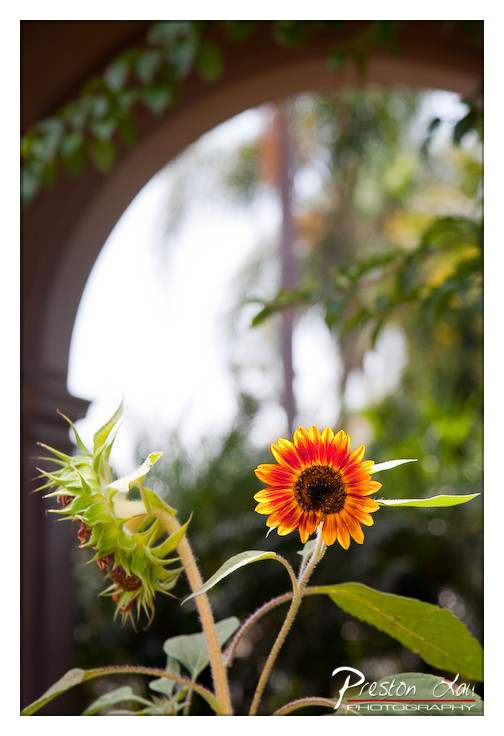

Sunflower Serenade: The Diva and the Drowsy Bud
Rating: 8/10 (for the open flower's charm, the bud is still waking up)
Well, look here, we have a classic case of "beauty sleep vs. full bloom". On the right, we have the absolute diva of the scene, a fiery, vibrant sunflower basking in the light, clearly ready for its close-up. Its petals are radiating warmth and color, a perfect explosion of orange and yellow against the softer greens. On the left, however, sits the slightly less enthusiastic, slightly grumpy-looking bud, still tightly coiled and possibly regretting staying up late binging nature documentaries. The shallow depth of field is doing a stellar job here, making our two floral protagonists pop right off the screen, while the background melts into a dreamy bokeh soup of greens and browns, suggesting a peaceful garden scene with a hint of architectural interest from the blurred archway.
Compositionally, placing the vibrant flower slightly off-center works well, giving it room to breathe, although the sleepy bud does pull the eye a bit to the left, creating a dynamic tension. The lighting seems soft but effective, really highlighting the textures on the petals and stems. The color palette is warm and inviting, centered around the rich tones of the open flower contrasting nicely with the cooler greens. It's a straightforward nature shot, but executed effectively to showcase the beauty of these individual plants. The photographer's watermark sits discreetly, ensuring credit is given to the creator of this charming little moment of garden drama.
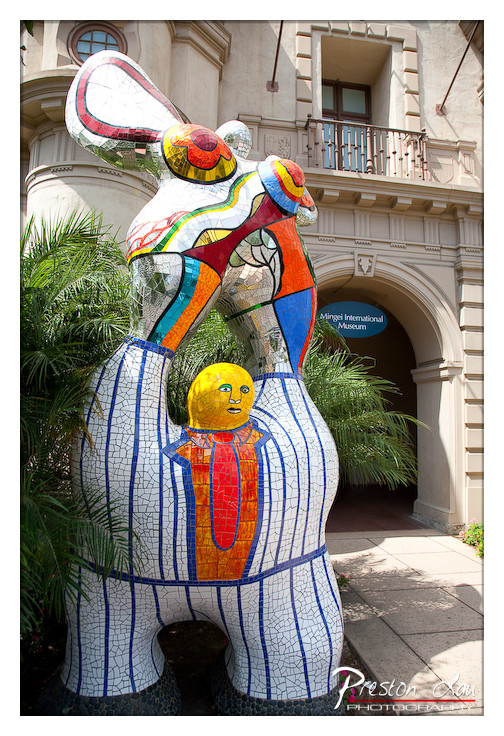

Mingei Museum Mascot?
Rating: Subject: 8/10
Well, hello there, whatever-you-are! This vibrant mosaic sculpture, standing proudly (and somewhat quizzically) in front of the Mingei International Museum, is definitely the star of the show. Is it a space-bunny cradling a golden-headed humanoid? Is it just a Tuesday? Regardless, the mood is undeniably whimsical and artistic, befitting a museum dedicated to craft, folk art, and design. It’s a bold splash of color and texture that immediately grabs your attention, making you pause before heading inside to explore more curated wonders. This colorful creature seems to be guarding the entrance, possibly deciding if you're worthy of entering based on your appreciation for oversized, tessellated abstract figures.
From a photographic perspective, the composition is effective, centering the sculpture slightly to allow the beautiful museum architecture and sign to provide context. The diagonal lines of the walkway draw the eye nicely towards the entrance. The lighting on this sunny day really makes the mosaic tiles sparkle – you can almost feel the heat shimmering off those mirror pieces – though you get a few punchy shadows as a result of the bright sun. The color palette is dominated by the sculpture's wild hues contrasted with the muted tones of the building, a juxtaposition that highlights the artwork. It's a solid capture of public art in its setting, perfect for cataloging museum features, even if the subject itself looks ready to launch into orbit. The wide white border is a classic touch for presentation, giving the image a clean, gallery-like feel, emphasizing the artwork within.
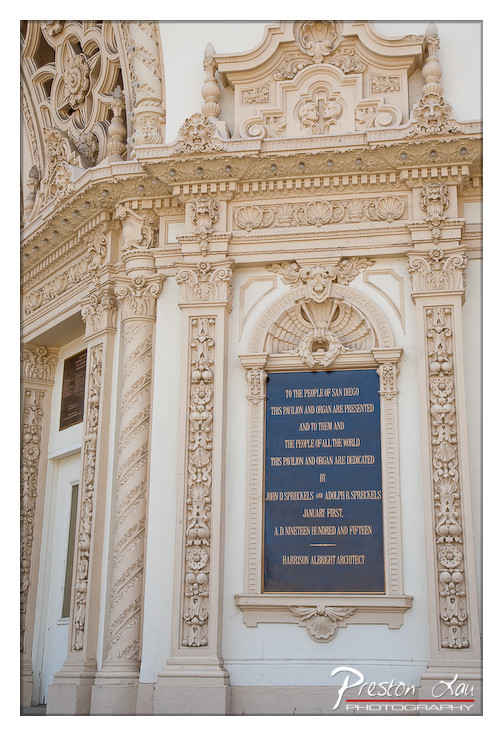

Ornamental Ode
Rating: 9/10
This image captures a close-up view of an incredibly ornate building facade, bursting with intricate carvings and decorative elements that seem to spill over one another. Dominating the center-right is a dark plaque with elegant white text, a historical marker dedicated by John D. and Adolph B. Spreckels in 1915, presenting and dedicating the pavilion and organ to the people of San Diego and the world, naming Harrison Albright as the architect. The surrounding architecture is a feast for the eyes – twisted columns, floral motifs, shell designs, and detailed friezes create a sense of grandeur and historical richness. The shot is taken from a low angle, emphasizing the height and solidity of the structure, and the mood is one of timeless elegance and dedication, a stone-etched declaration of a gift to a city.
From a photographic perspective, this shot is a great study in texture and detail. The soft, possibly overcast light, works well here, providing even illumination that minimizes harsh shadows and allows the intricate carvings to stand out without getting lost in contrast. The composition effectively frames the plaque while showcasing the lavish details around it, though cutting off the top feels a little abrupt, focusing solely on the mid-section's extravagance. The limited color palette of the stone and plaque highlights the forms rather than color dynamics. Capturing architecture with this level of detail requires careful focus and aperture selection to ensure everything is sharp, and the photographer has largely succeeded, letting us appreciate the craftsmanship of over a century ago – a true testament to "they just don't build 'em like they used to," thank goodness for the carvers' job security back then!
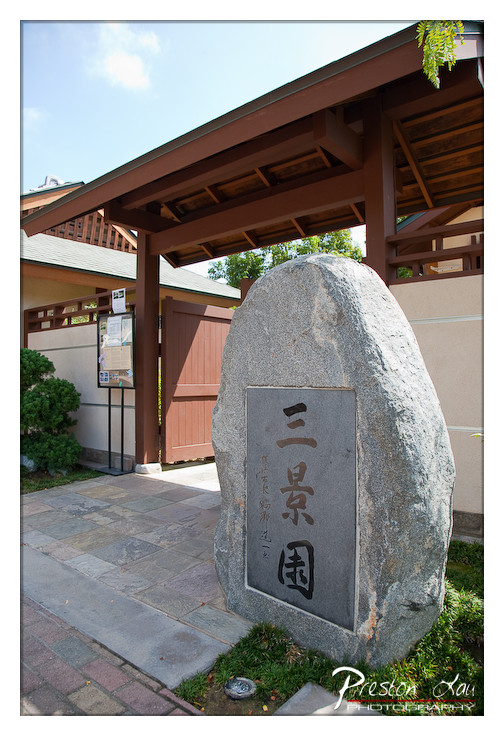

Entrance Stone Guardian
Rating: 7/10
Behold, the majestic gateway marker! This image captures the serene entrance to what appears to be a tranquil Japanese garden, marked by a substantial, grey stone proudly displaying bold Japanese characters on a darker plaque. The stone, a weighty guardian at the threshold, dominates the right side of the frame, its rough texture and the carved inscription immediately drawing the eye and hinting at the cultural significance within. To the left, a traditional-style wooden entrance structure with a brown tiled roof offers a glimpse into the space beyond a partially visible wooden gate. A paved path leads towards the entrance, flanked by manicured greenery and a small information stand, suggesting a place open to visitors. The mood is peaceful and inviting, despite the imposing stone, set against a bright, sunny sky that promises a pleasant day for exploration.
From a photographer's perspective, the composition works well, with the stone balancing the architectural elements on the left, creating depth and leading the viewer's eye inwards. However, the midday sun is less forgiving, casting strong, contrasty shadows and blowing out the sky slightly – a common challenge when shooting under direct light. The lighting accentuates the texture of the stone but creates a bit of a harsh look overall. The earthy color palette of browns, greys, and greens is natural and fitting for the subject matter. Style-wise, it's a straightforward documentary shot of a location entrance. And oh, Preston, your watermark is almost as prominent as the stone itself – no one's stealing this giant rock photo! Perhaps a slightly less intrusive placement or size next time? Overall, it's a competent shot capturing the essence of the entrance, though wrestling with the lighting could have elevated it further.
Loading map...